
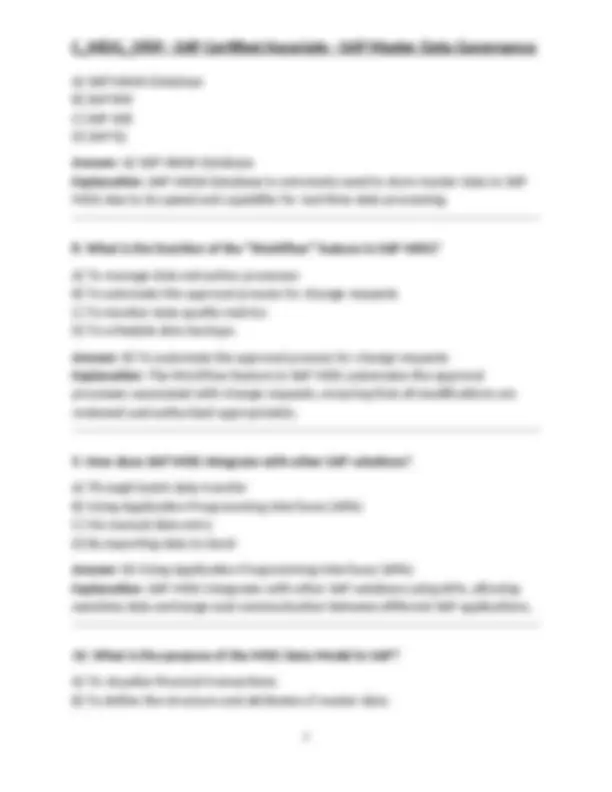
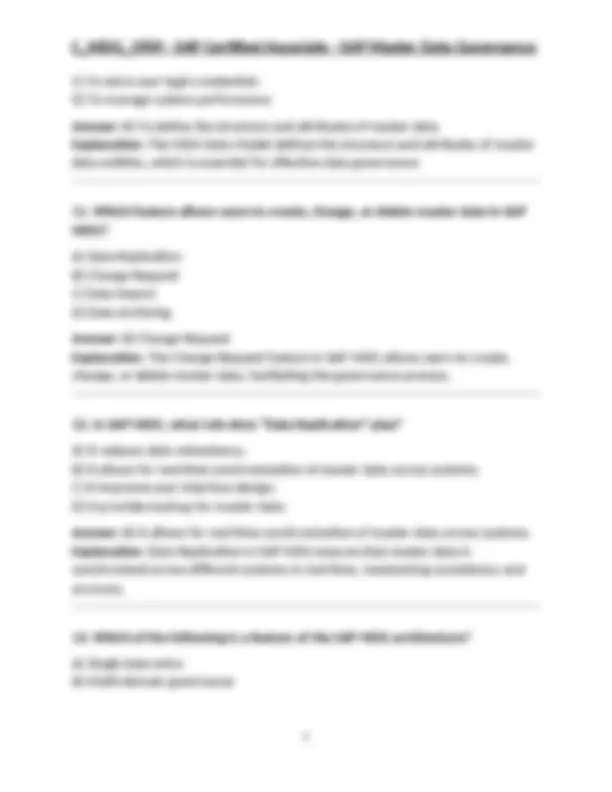
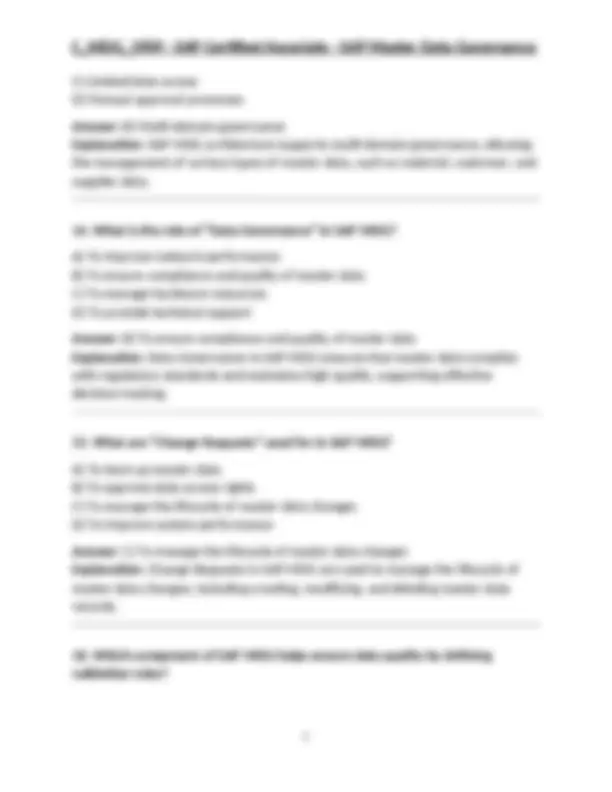
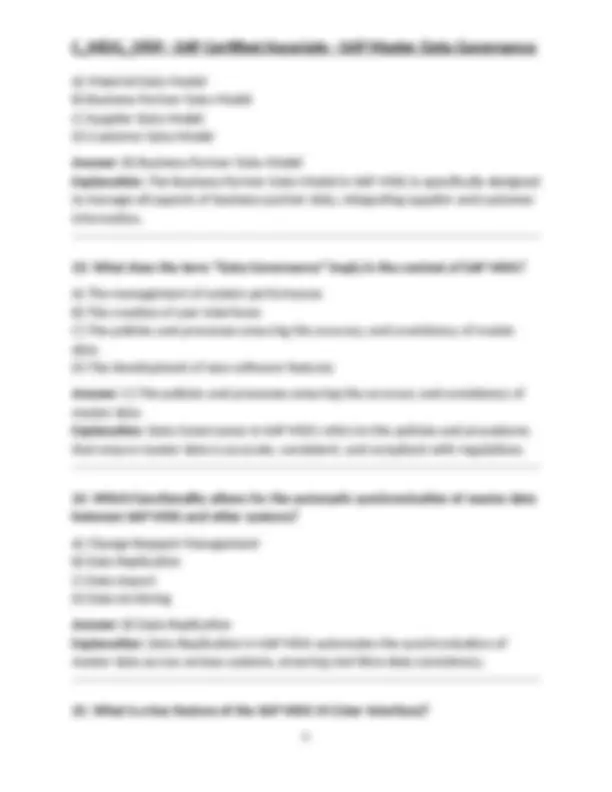
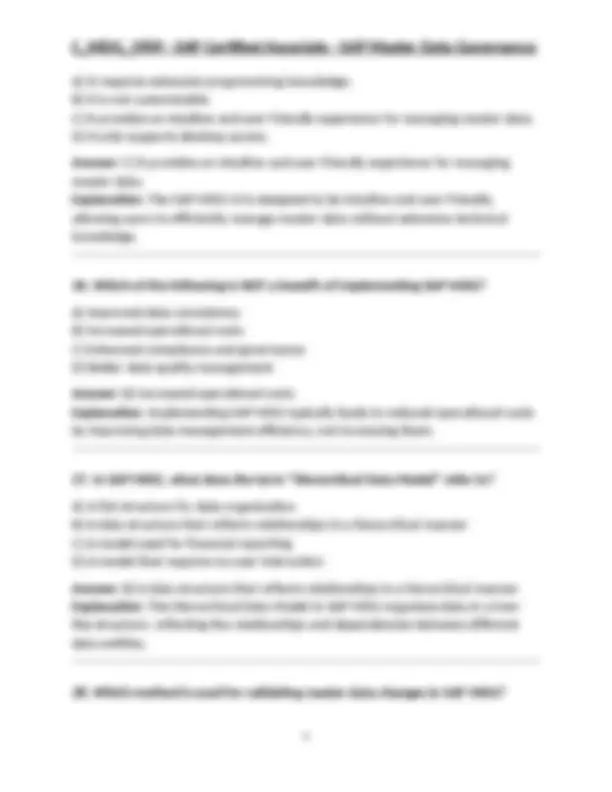
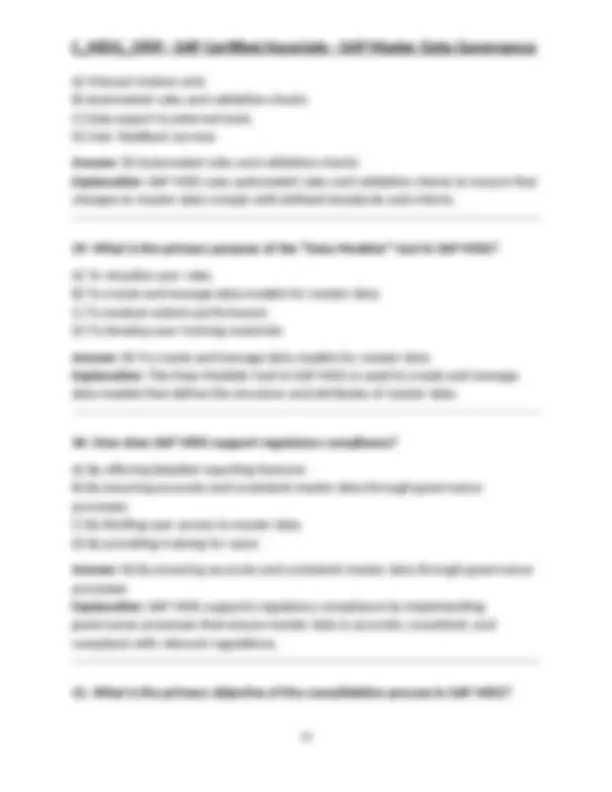
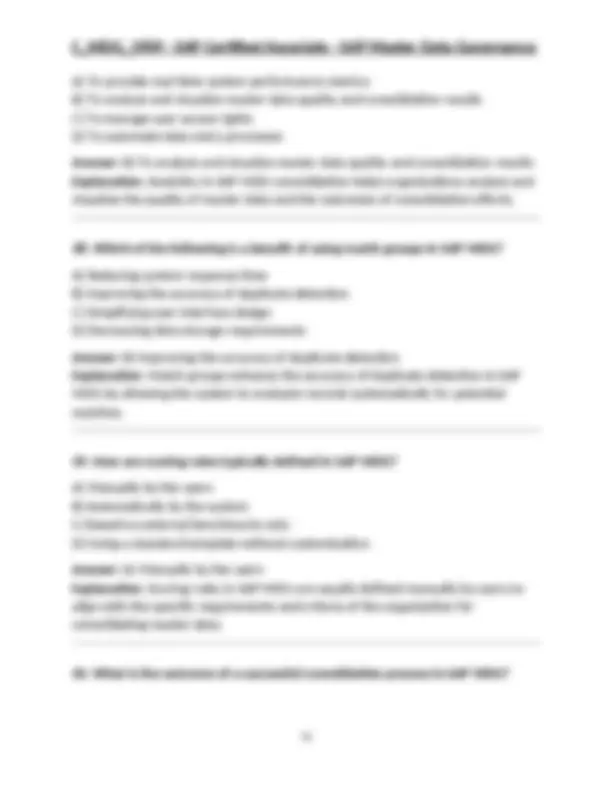
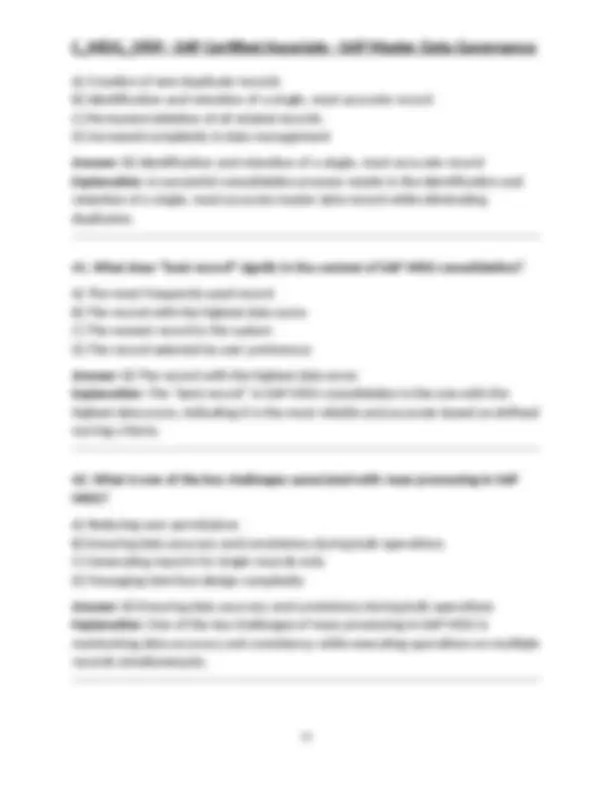
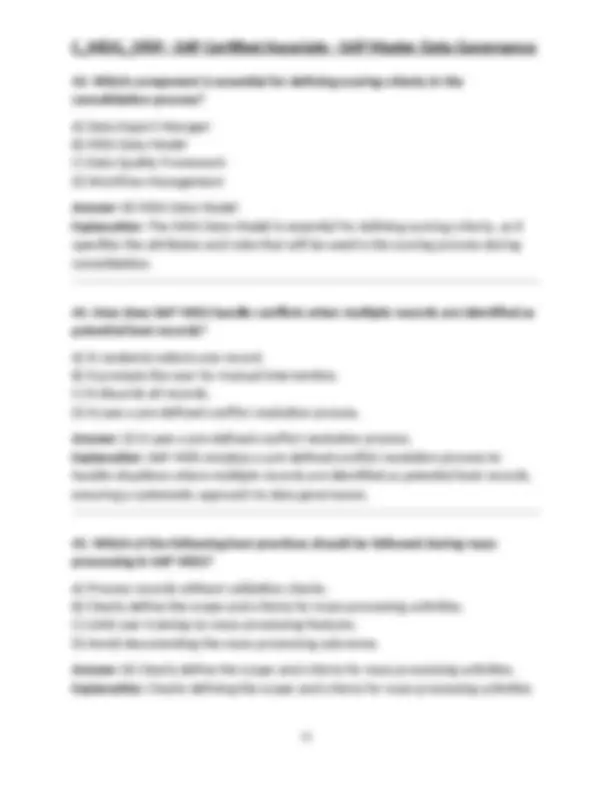
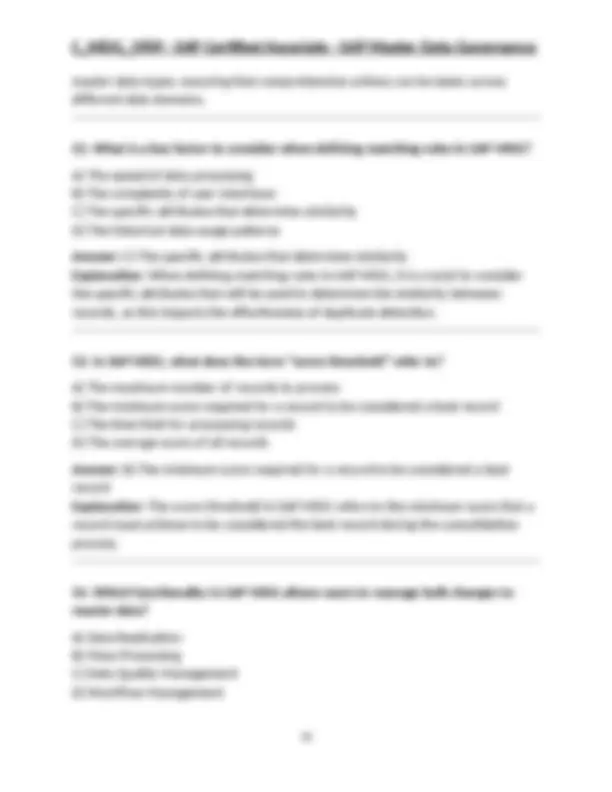
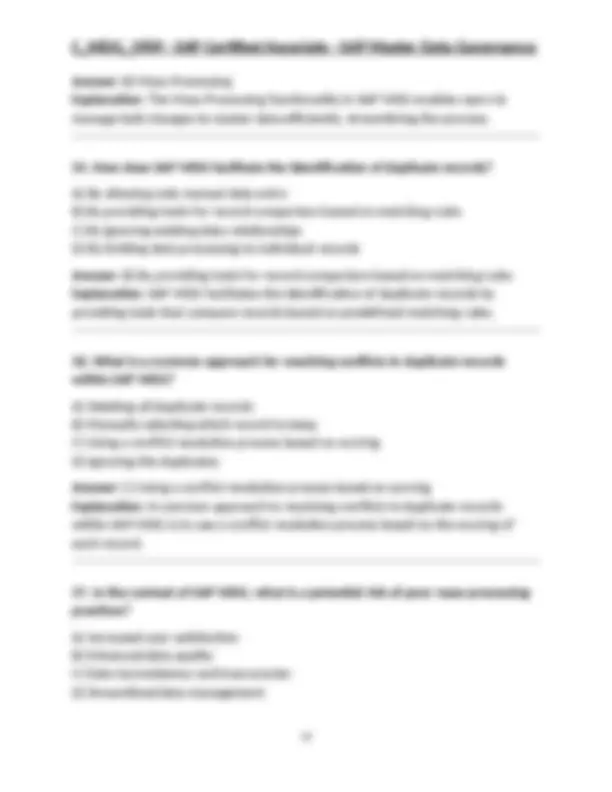
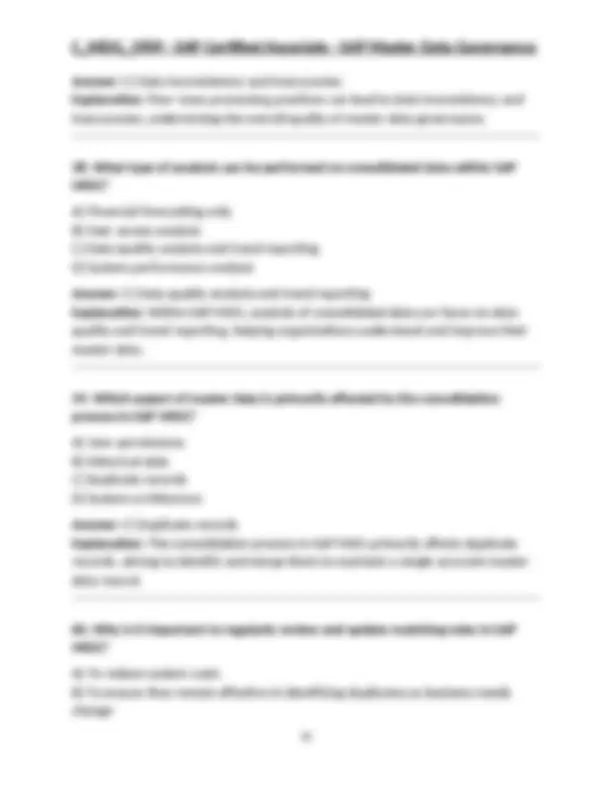
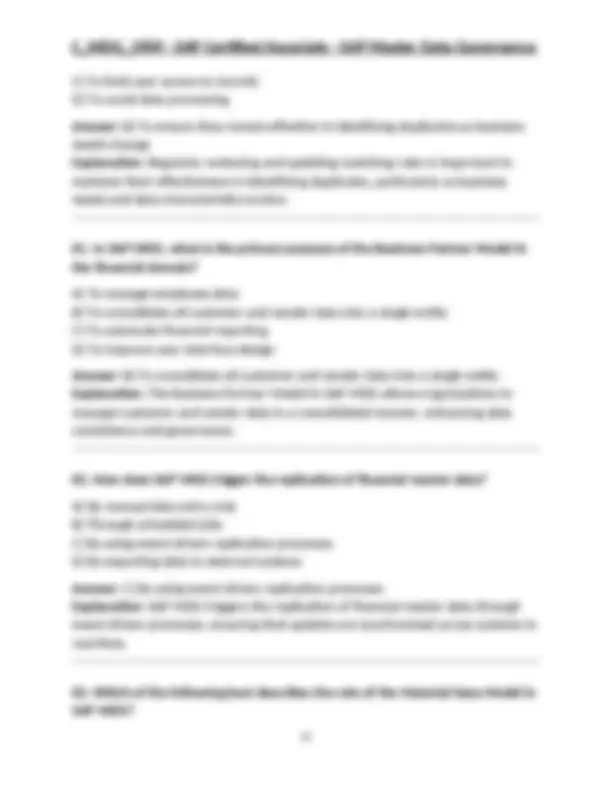
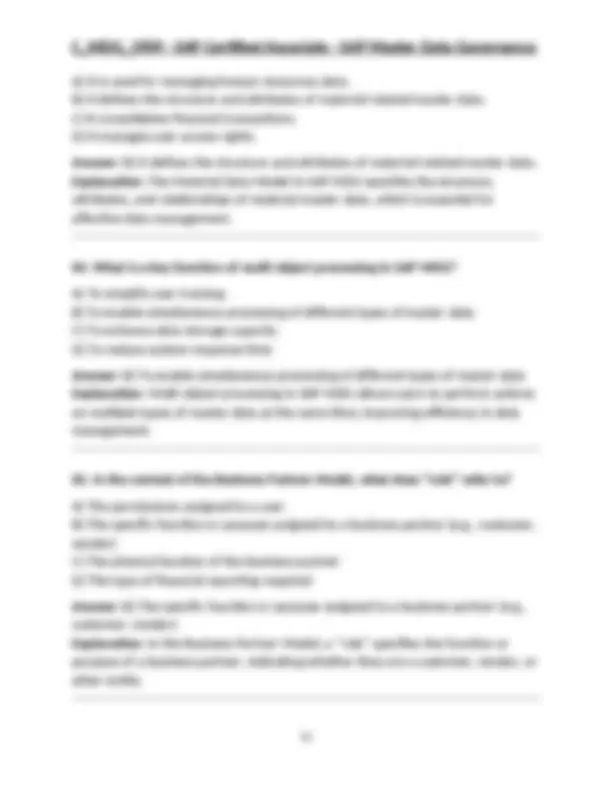
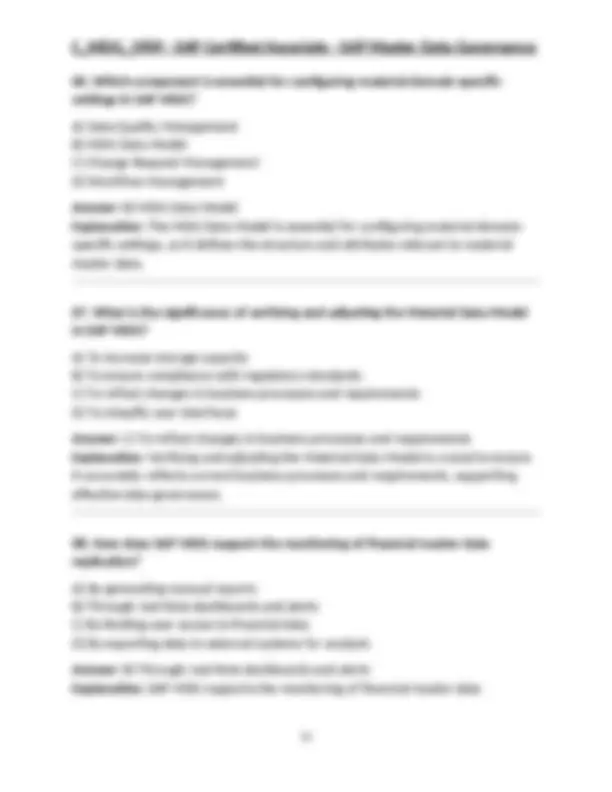
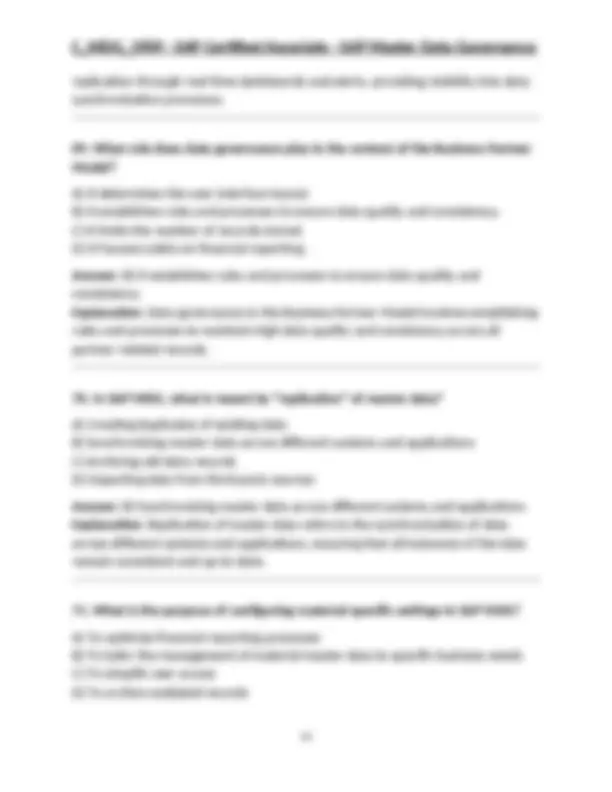
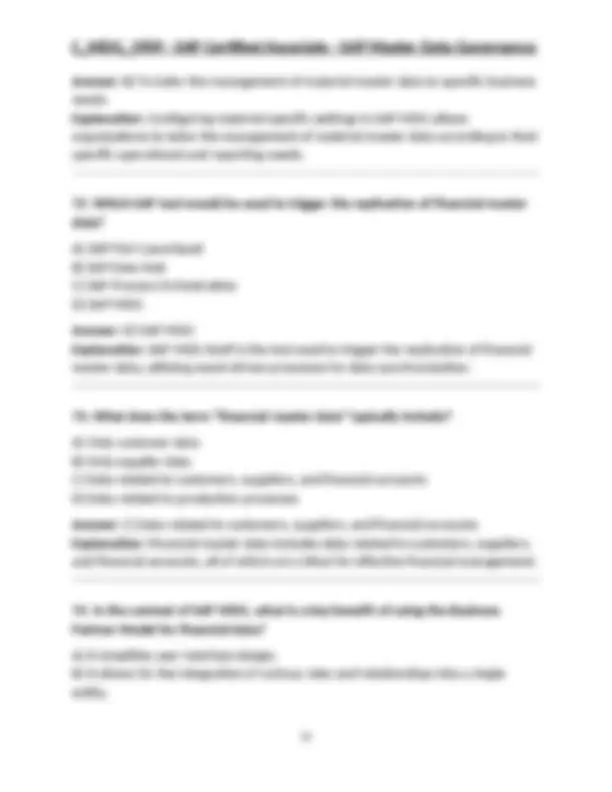
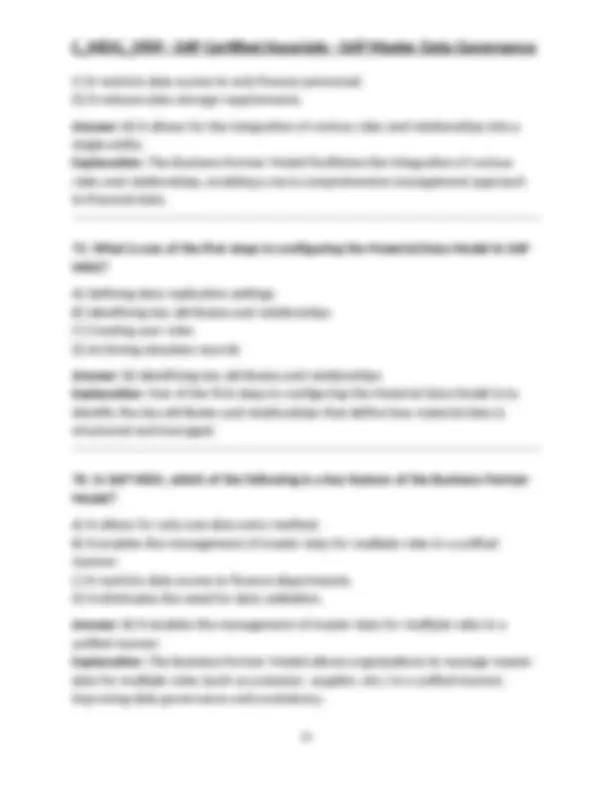
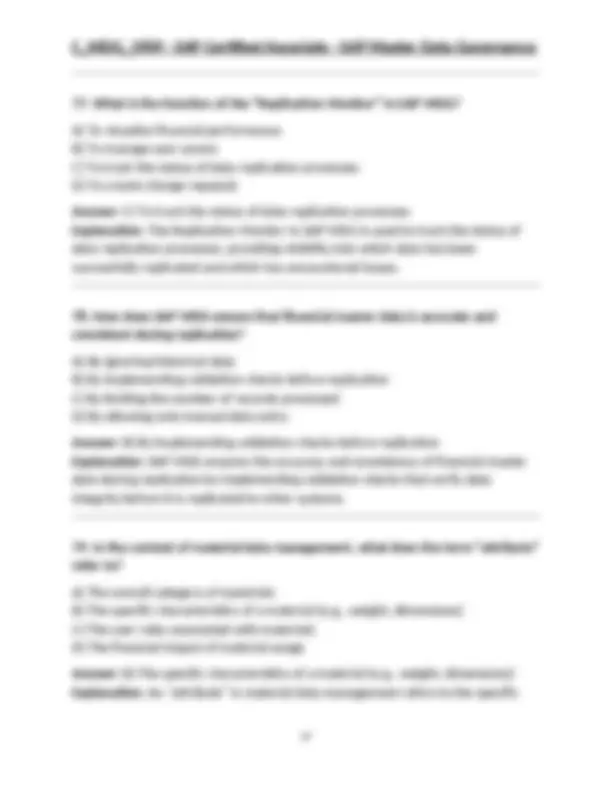
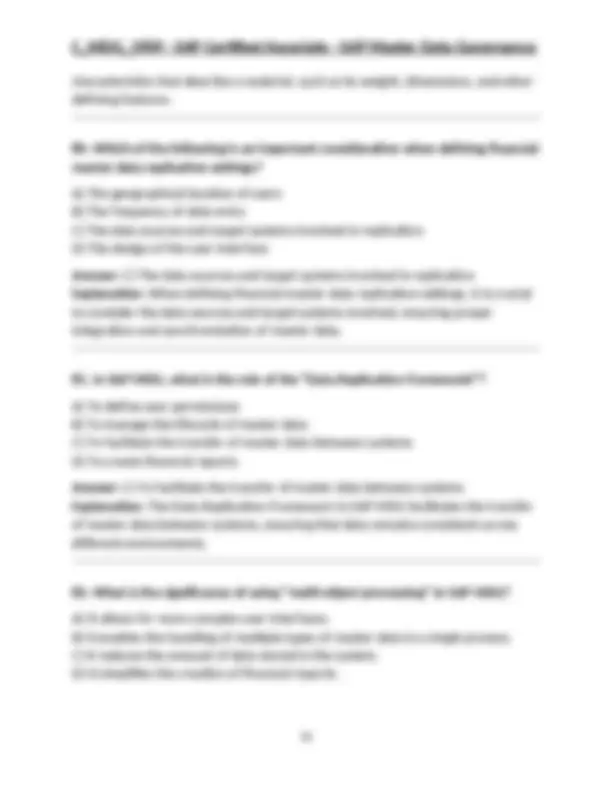
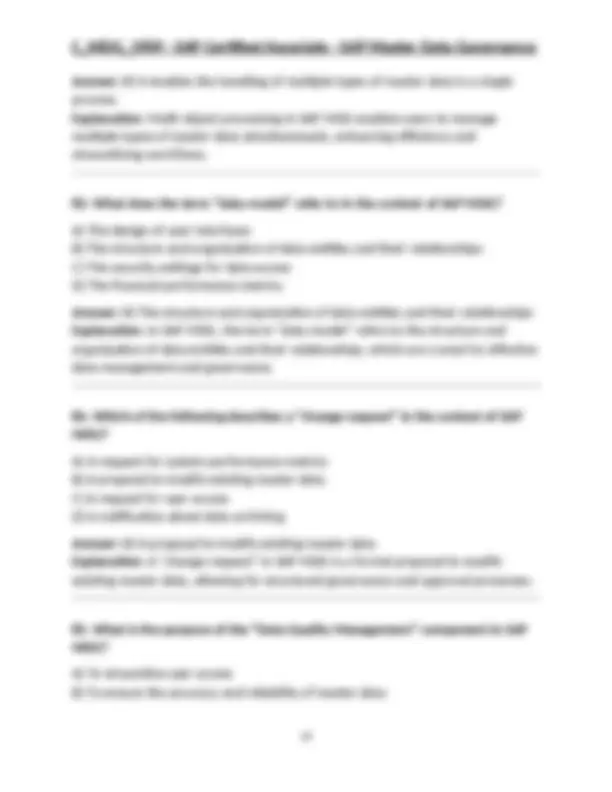
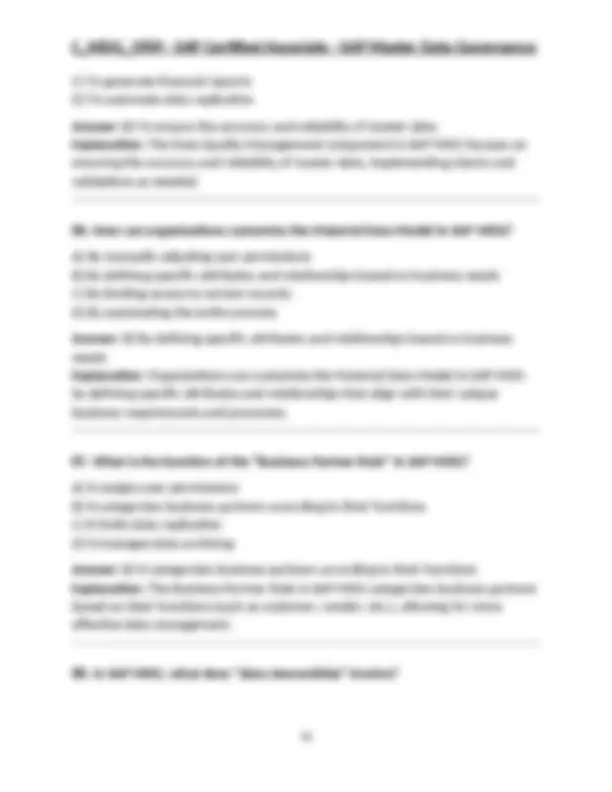
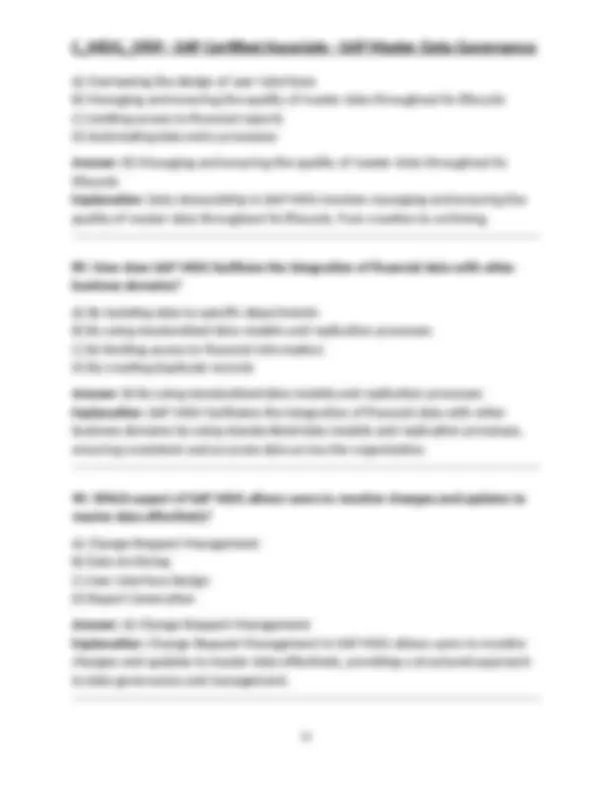
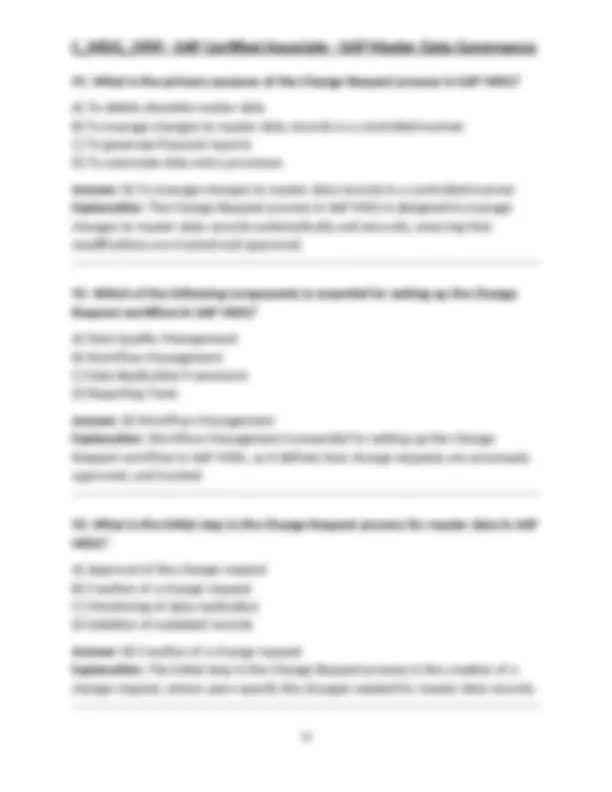
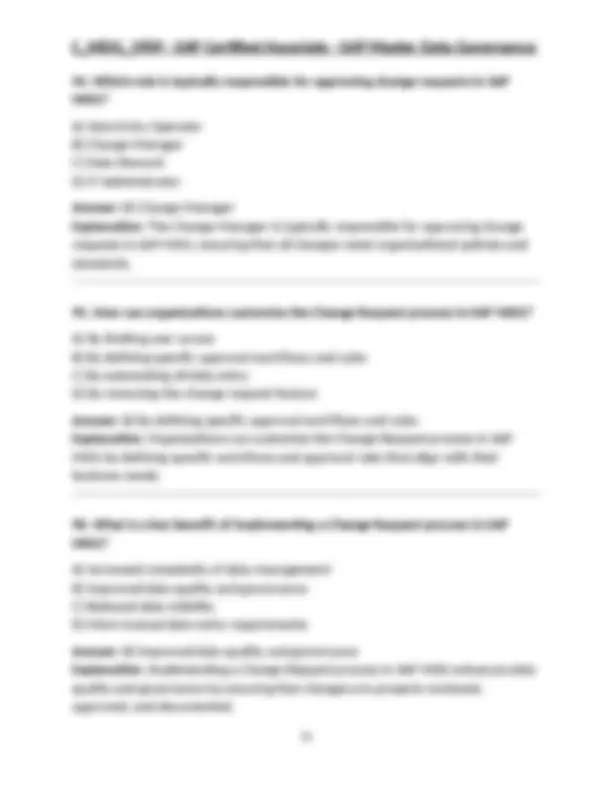
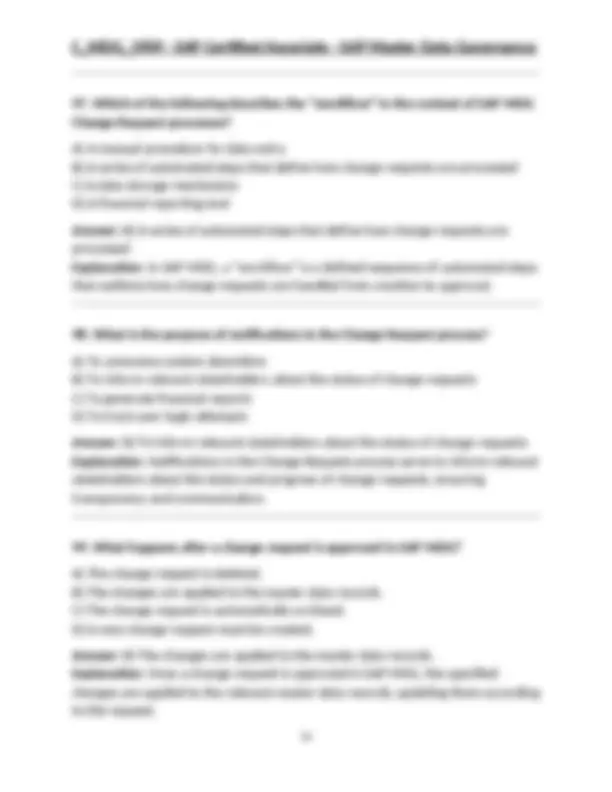
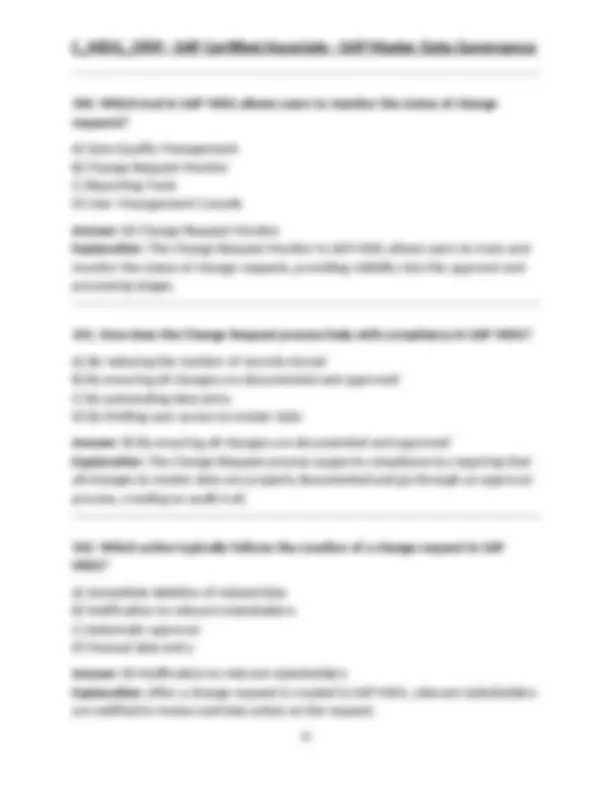
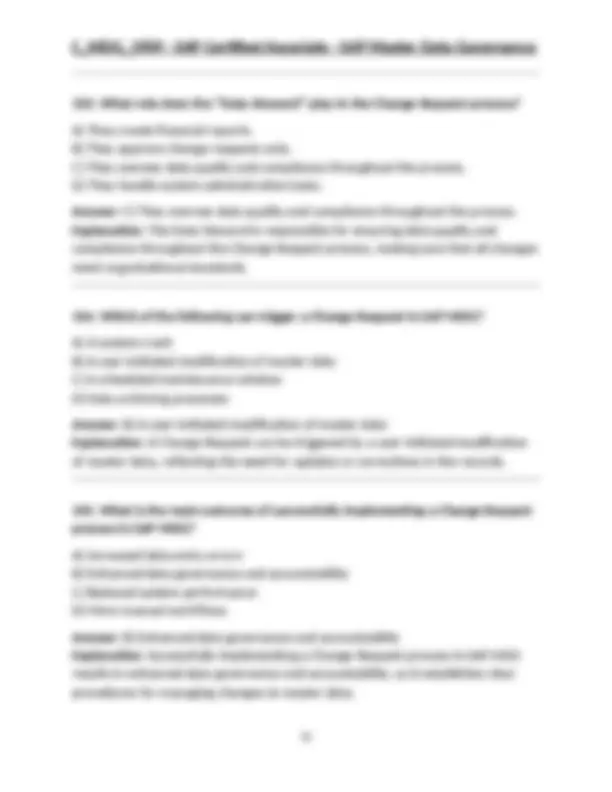
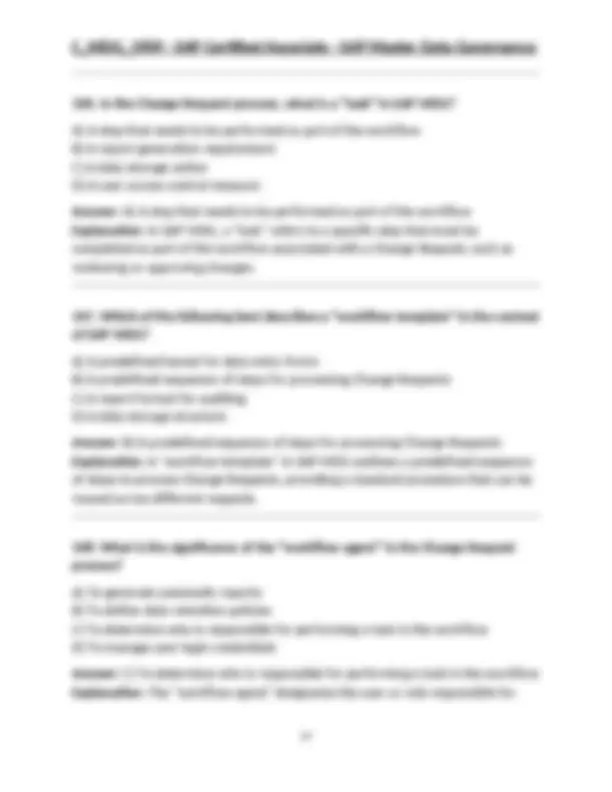
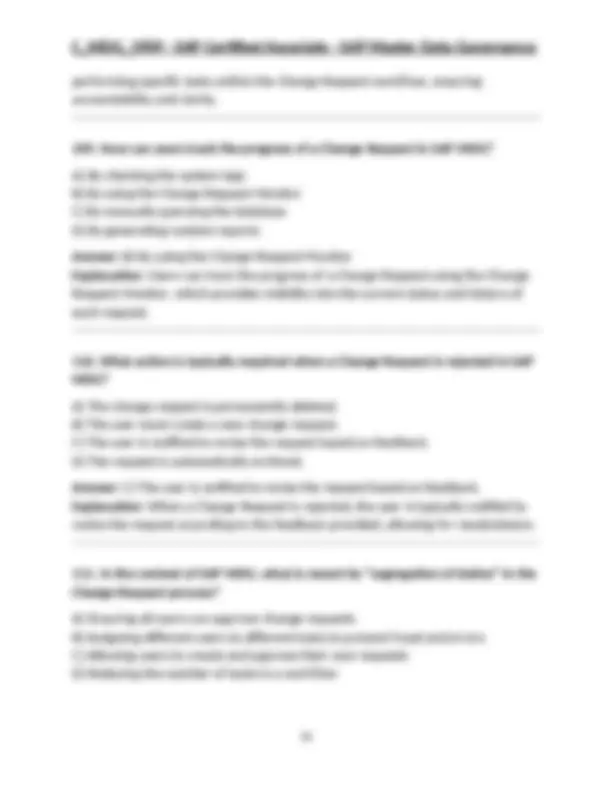
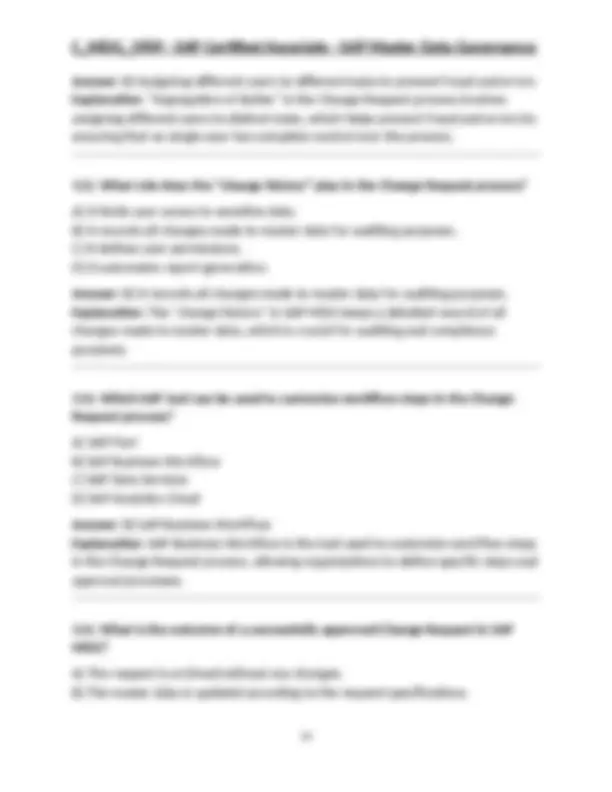
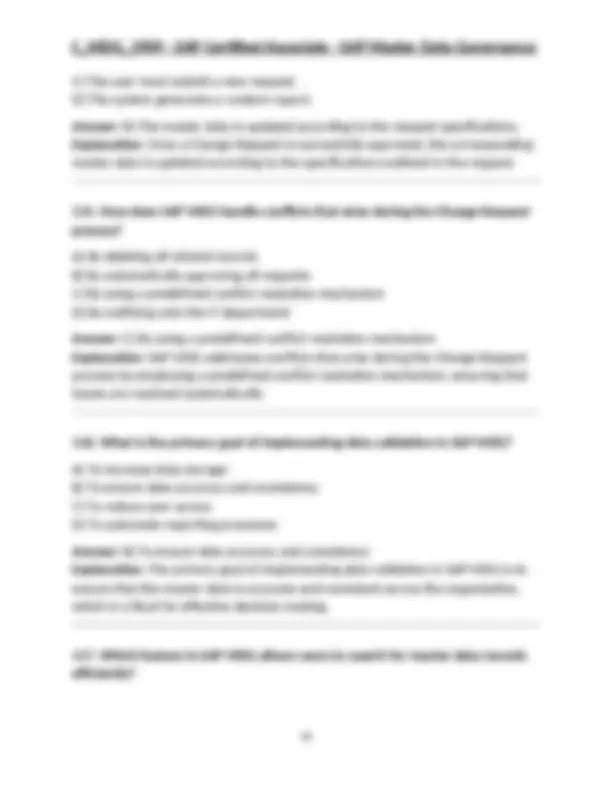
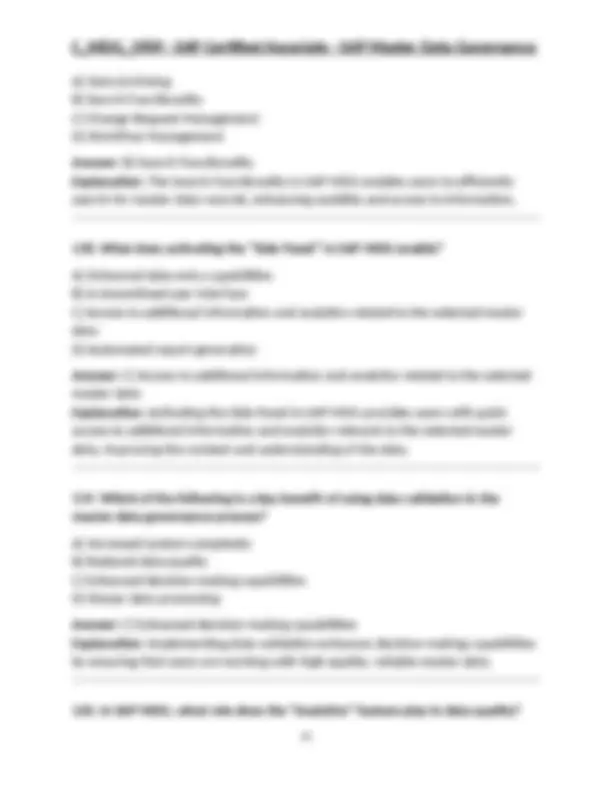
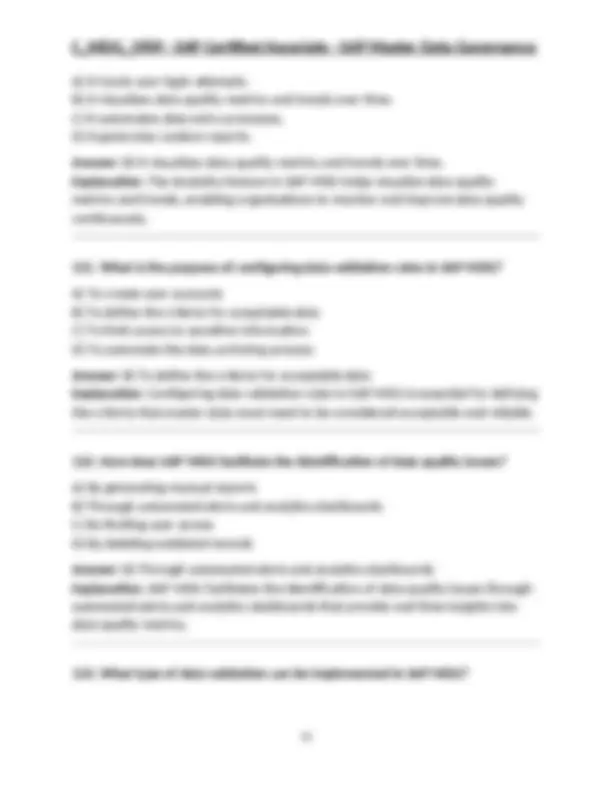
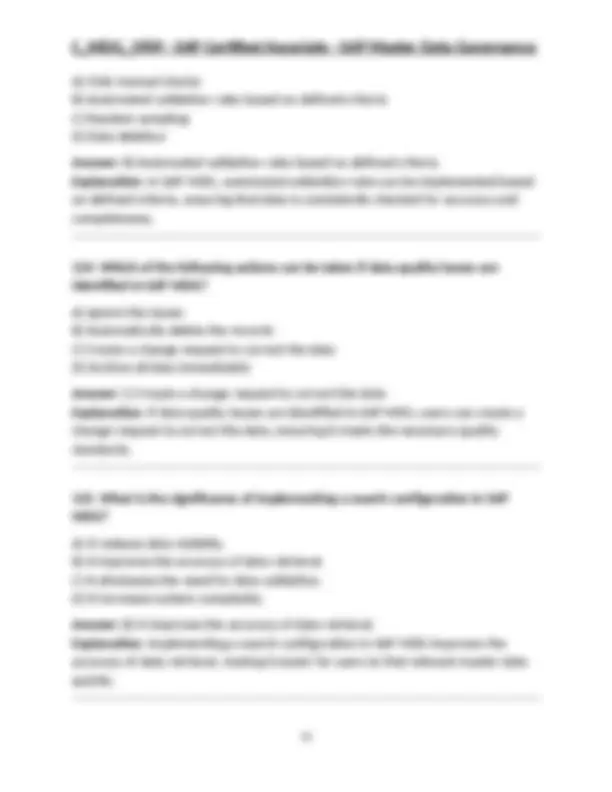
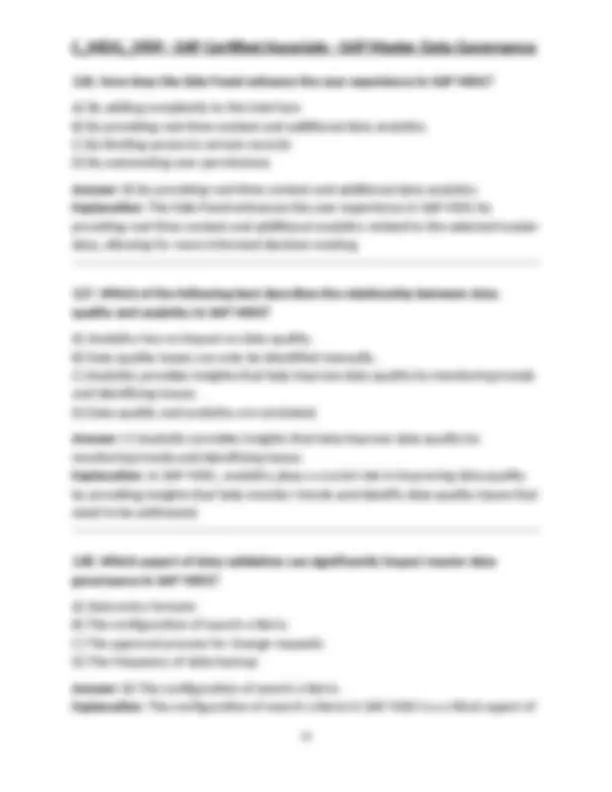
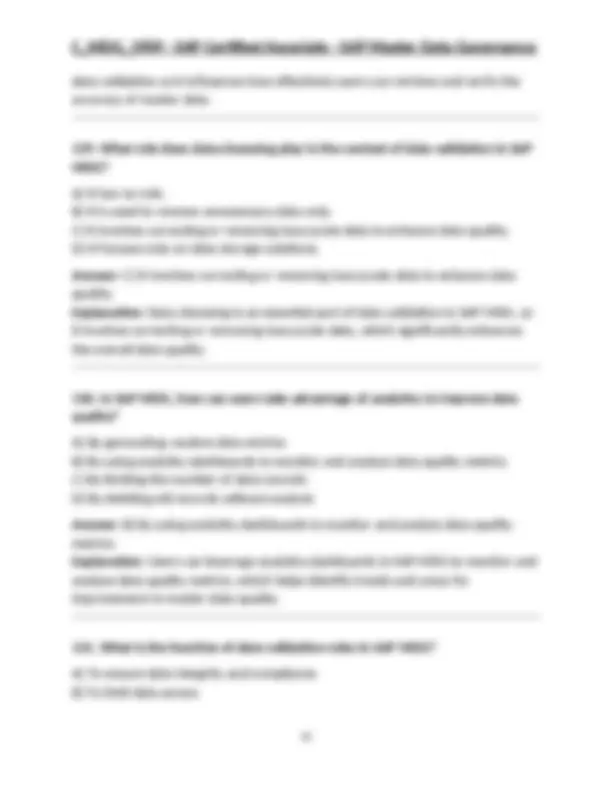
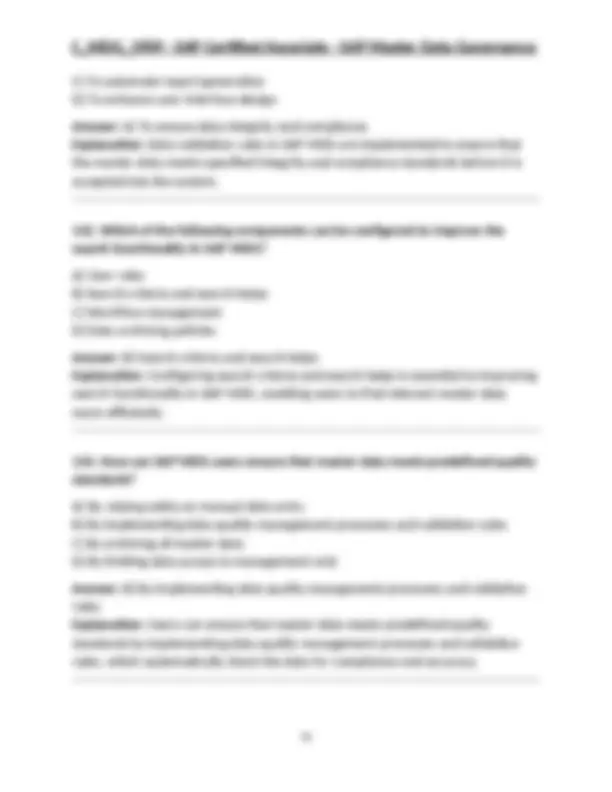
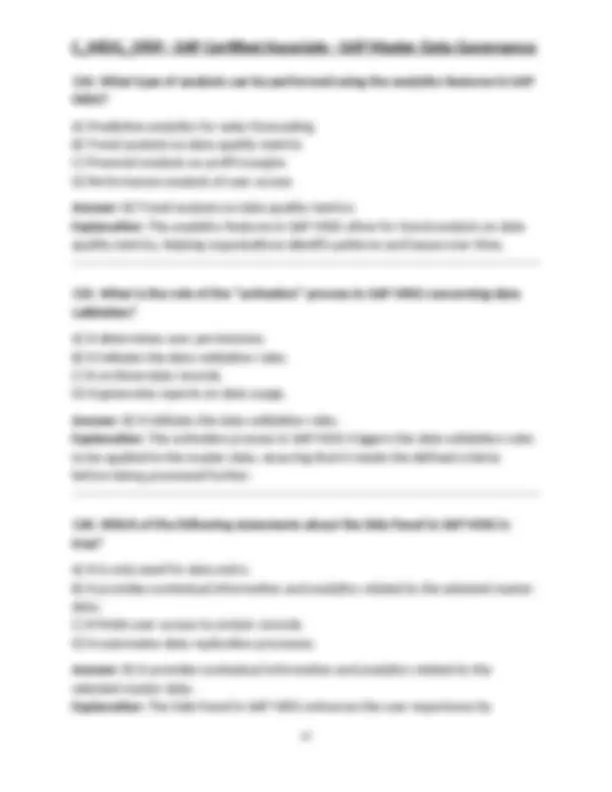
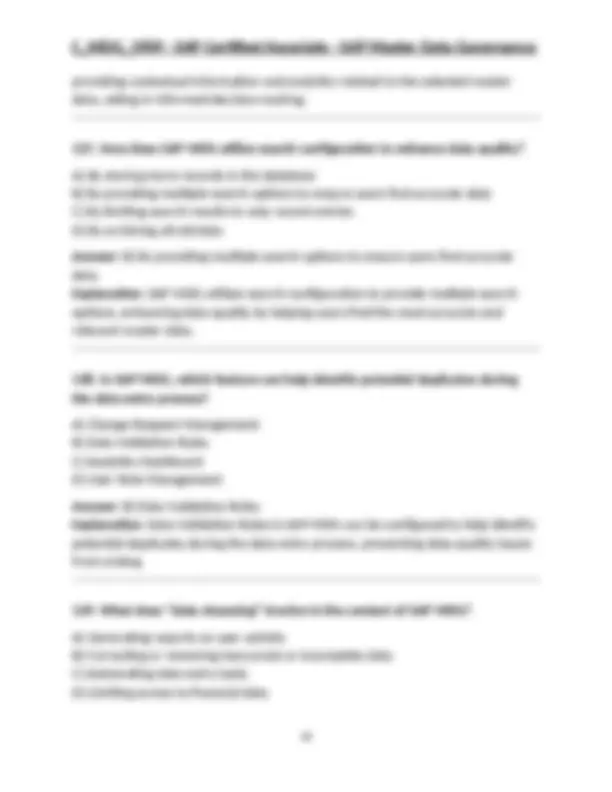
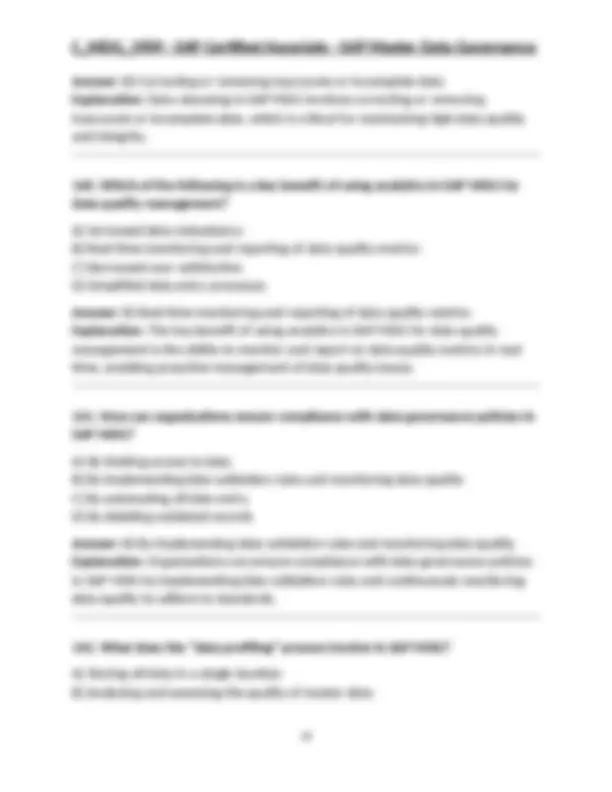
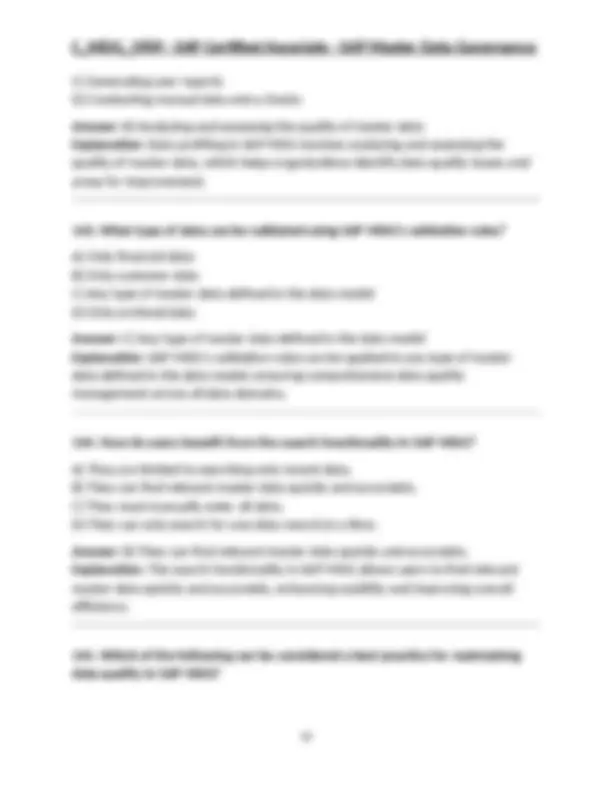
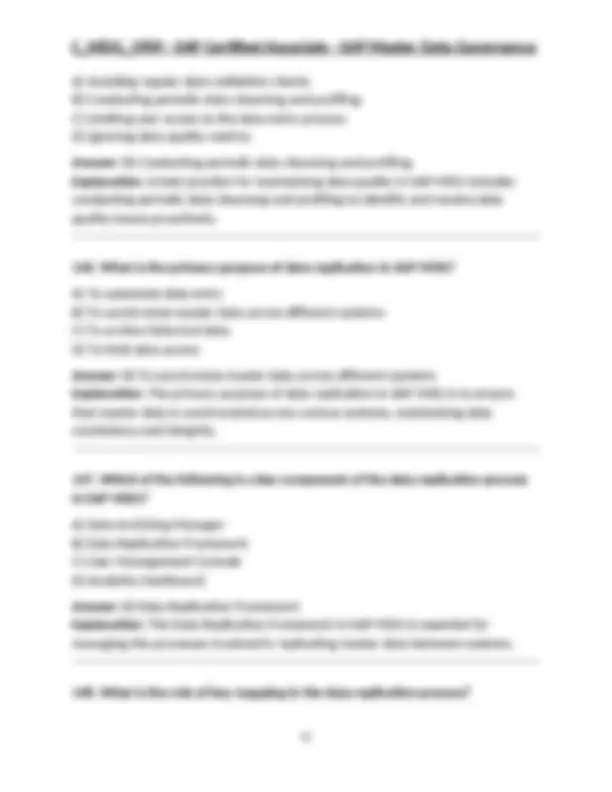
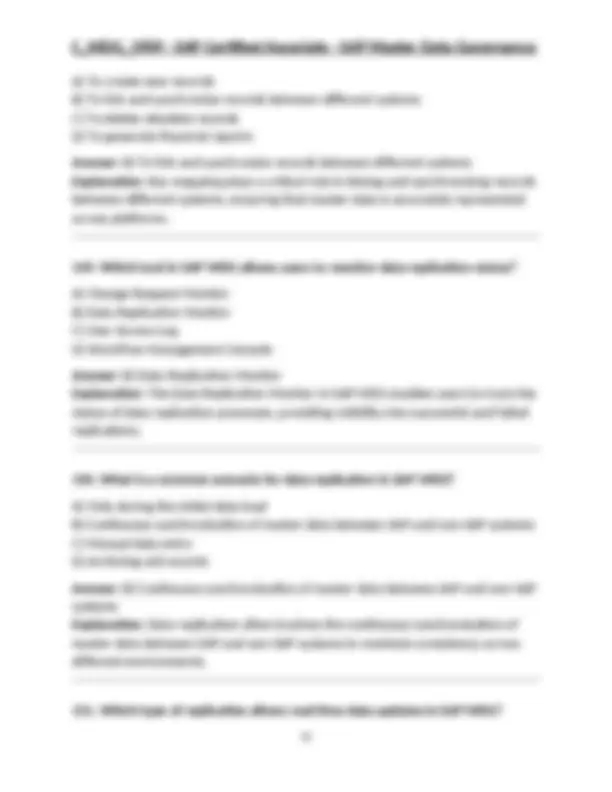
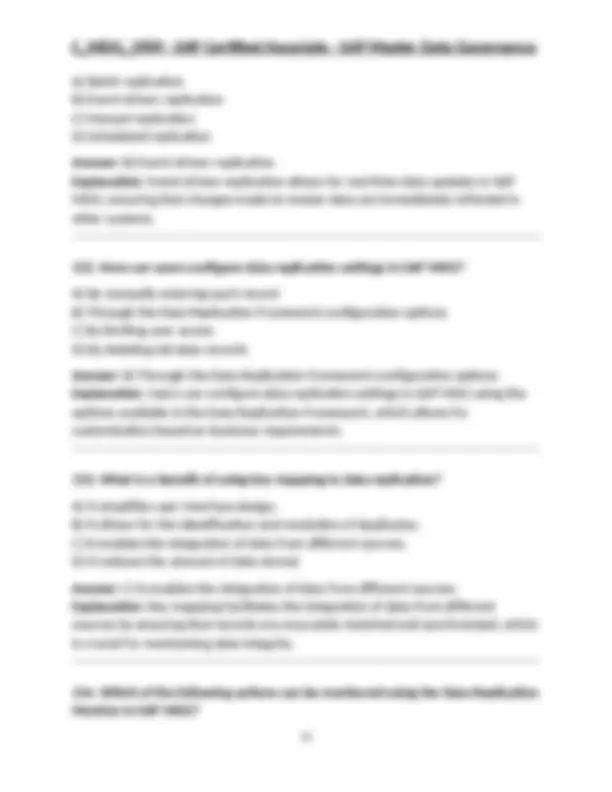
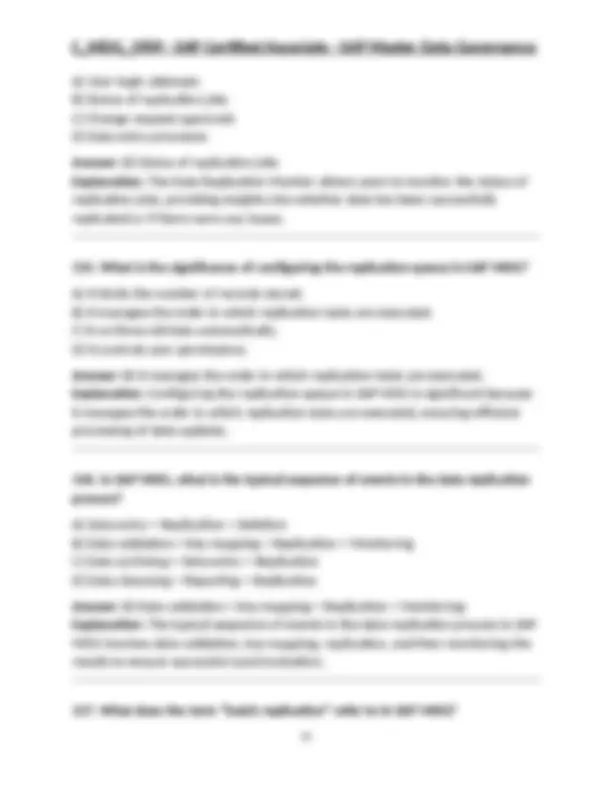
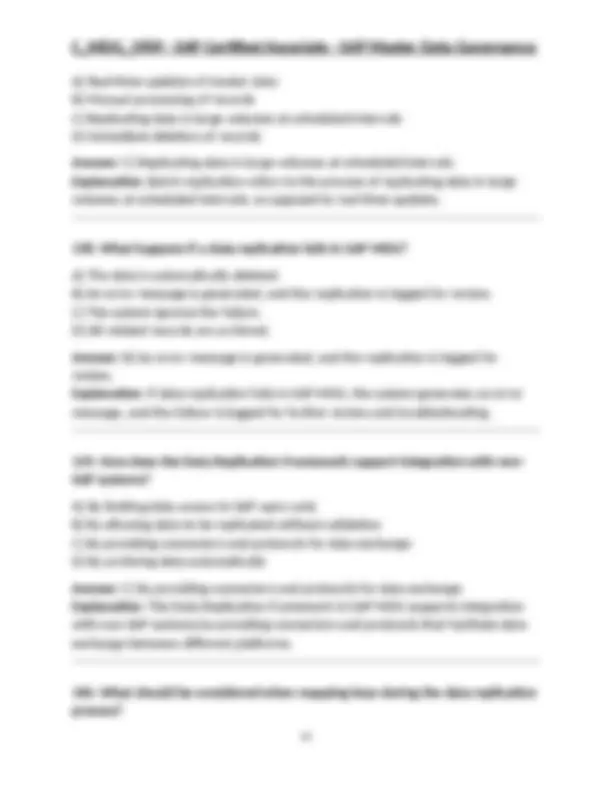
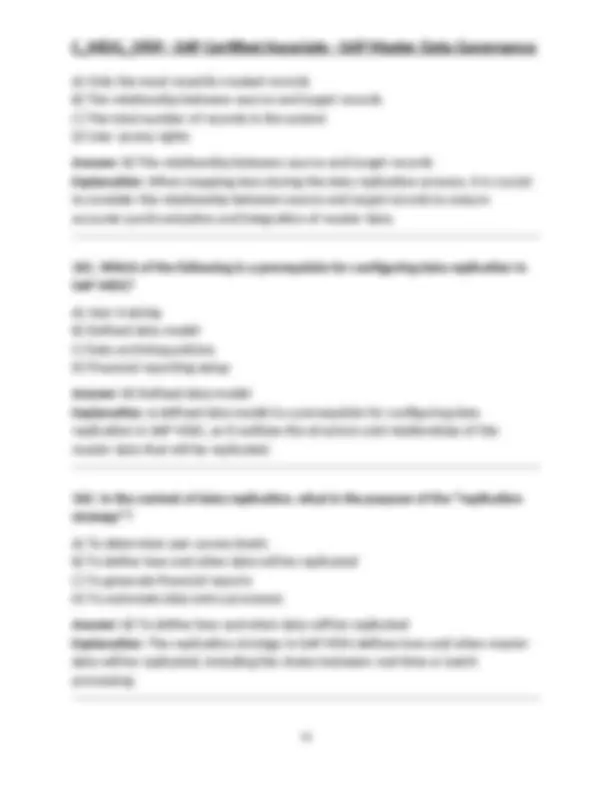
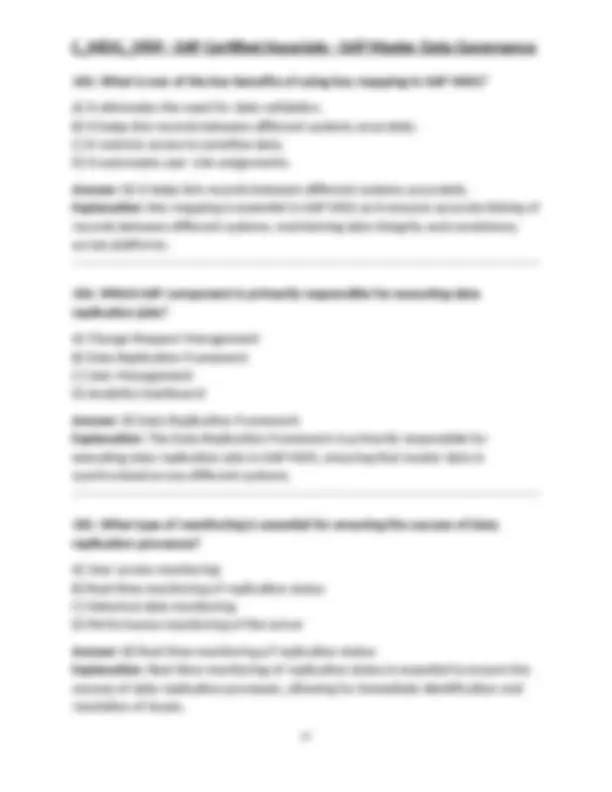
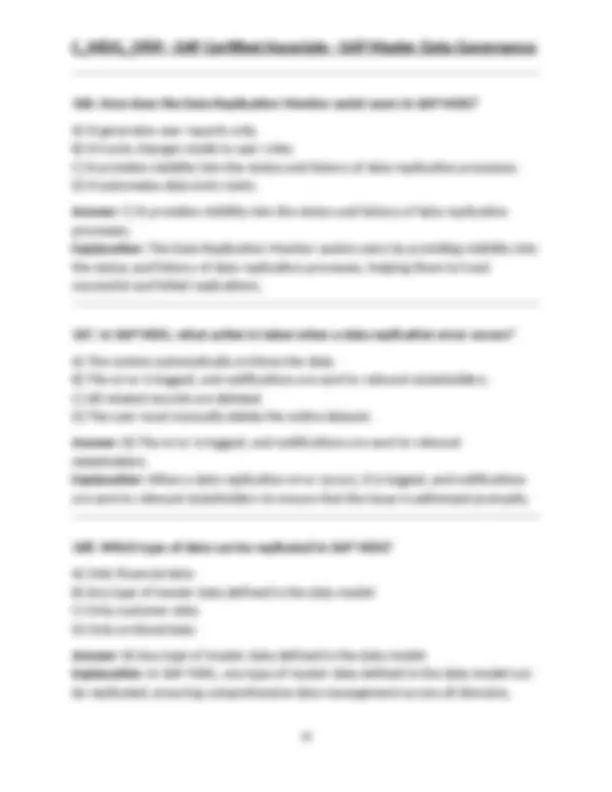
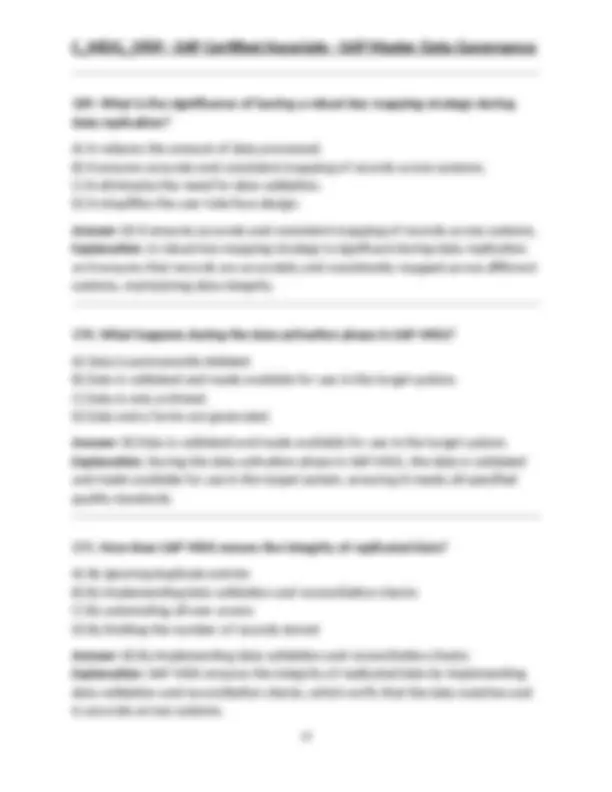
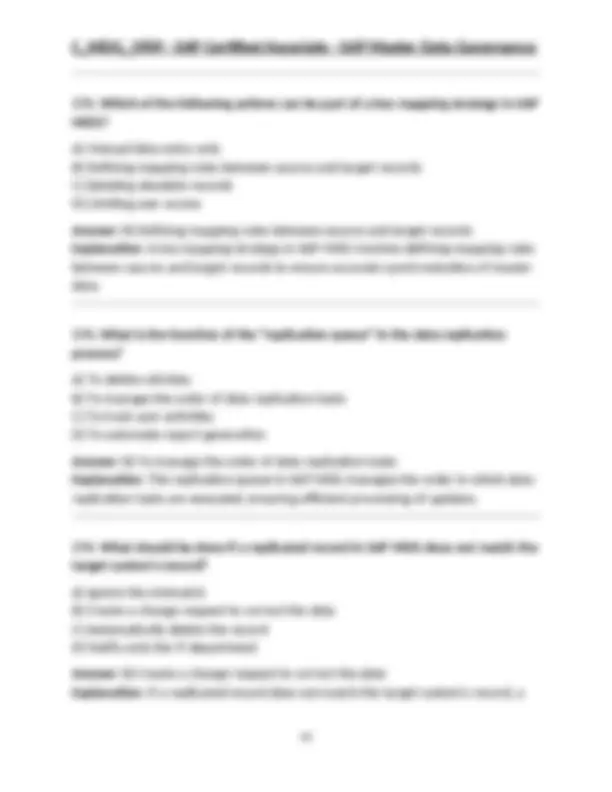
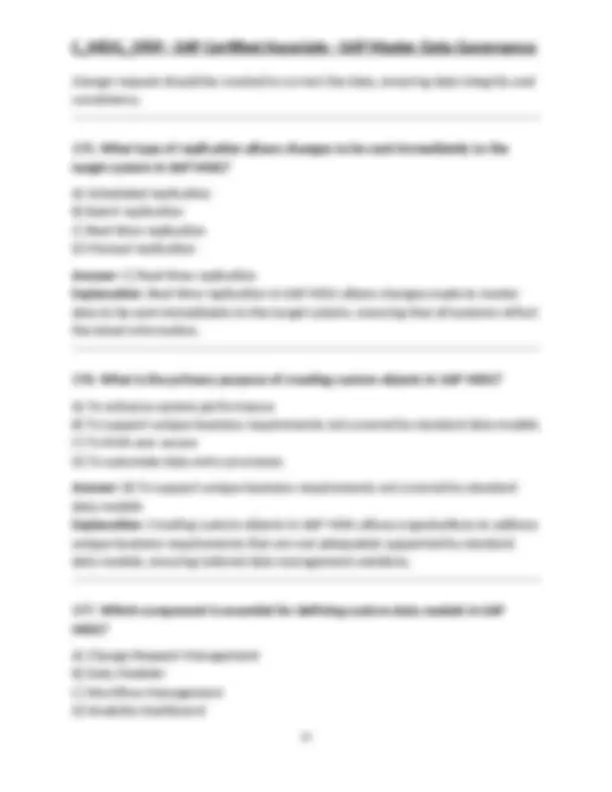
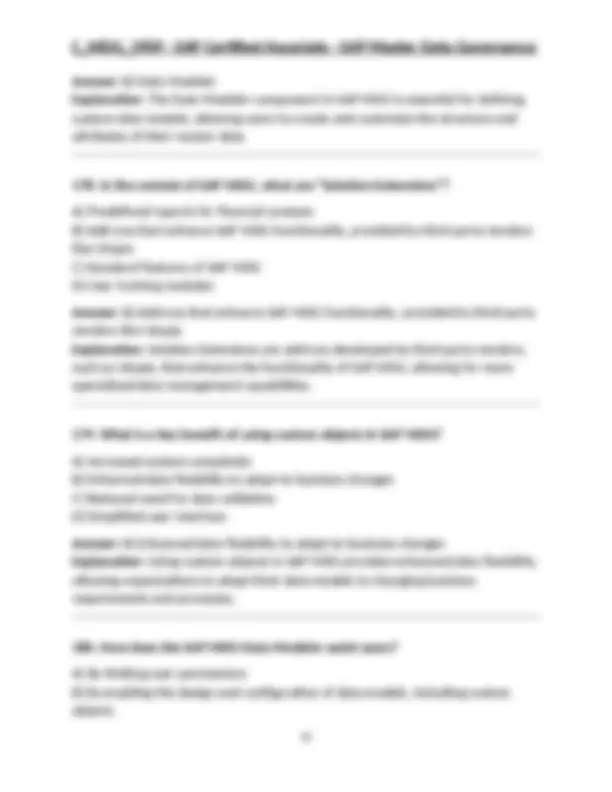
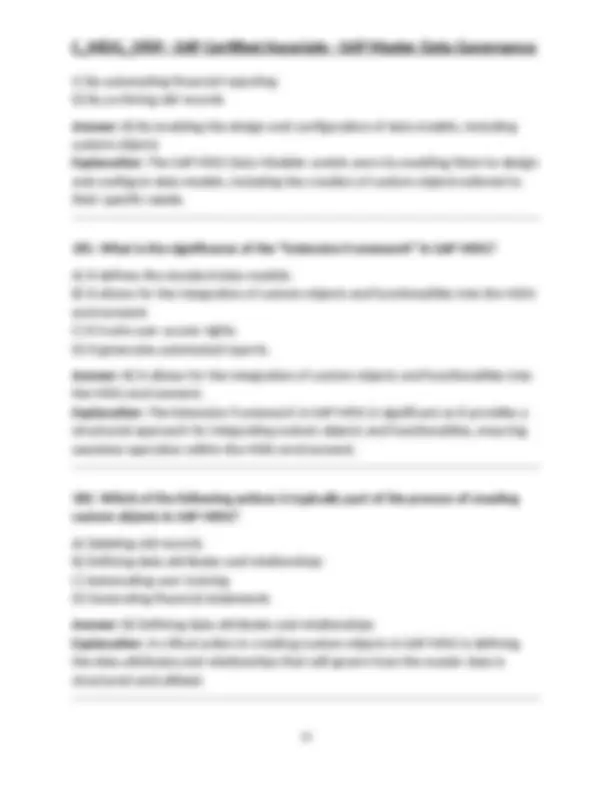
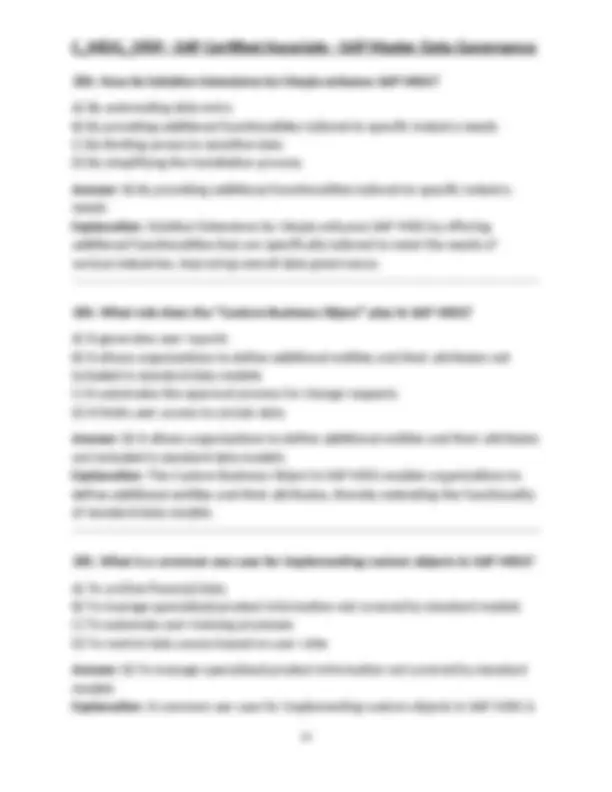
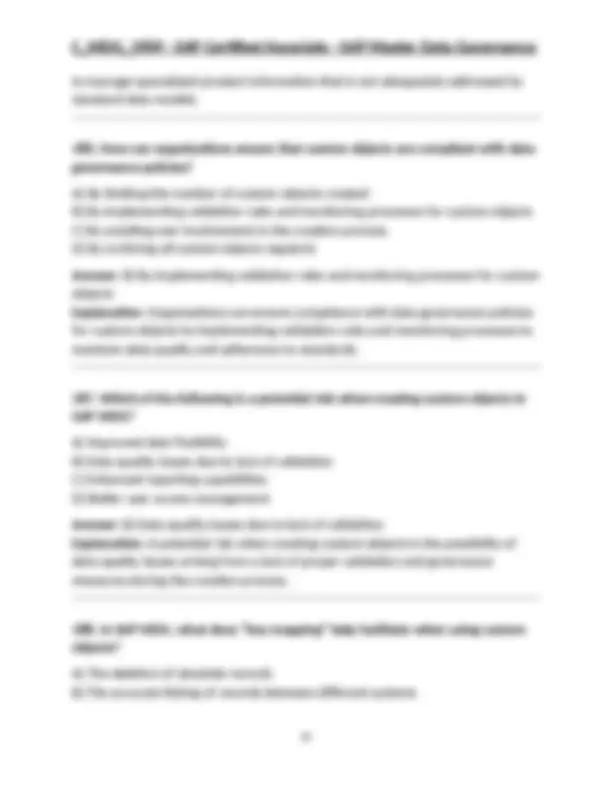
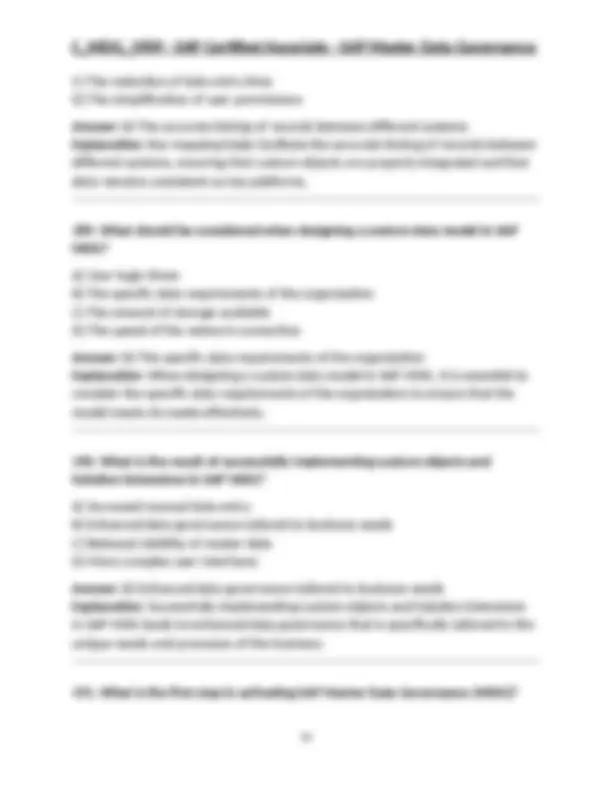
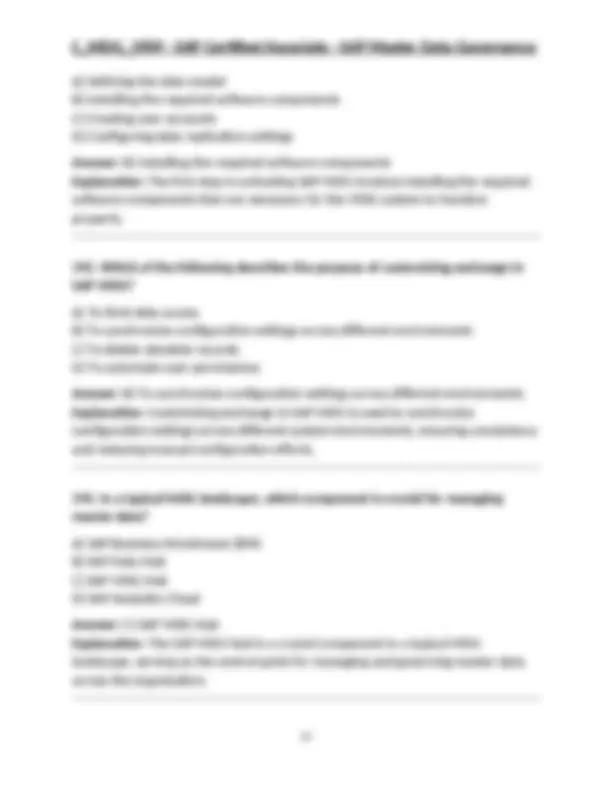
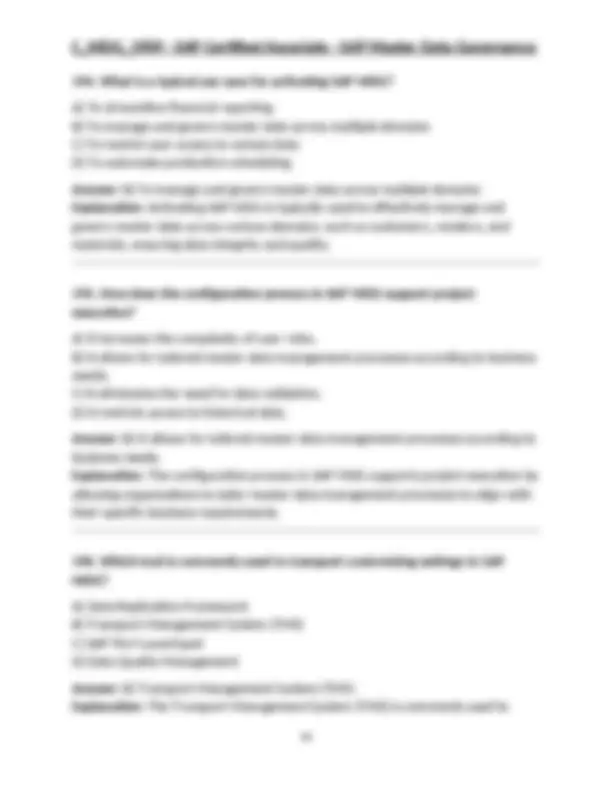
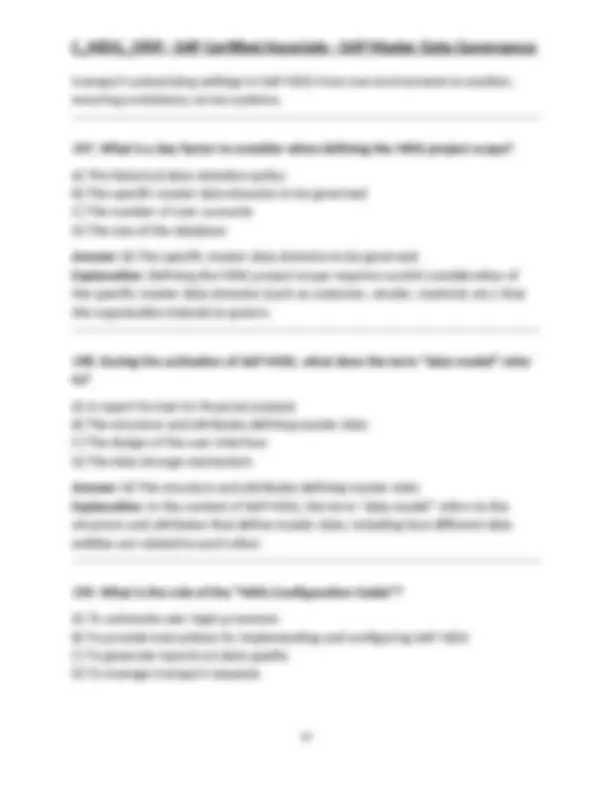
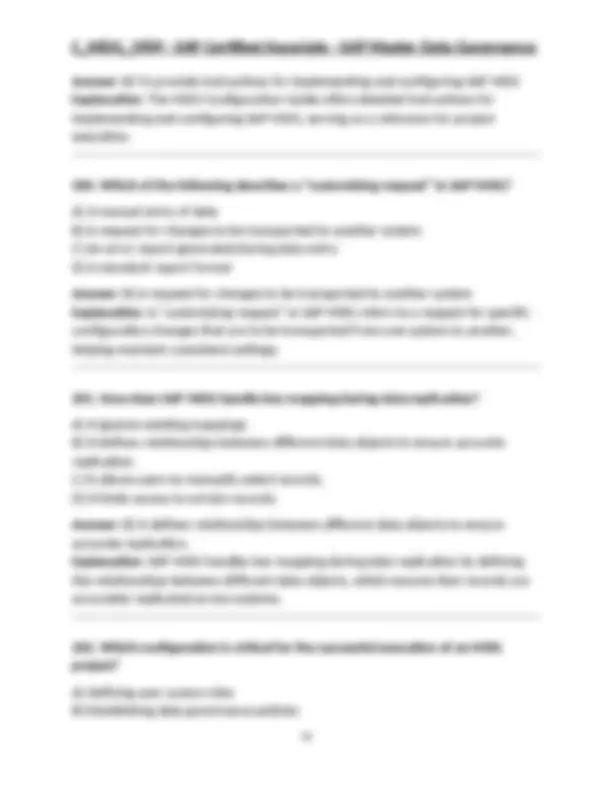
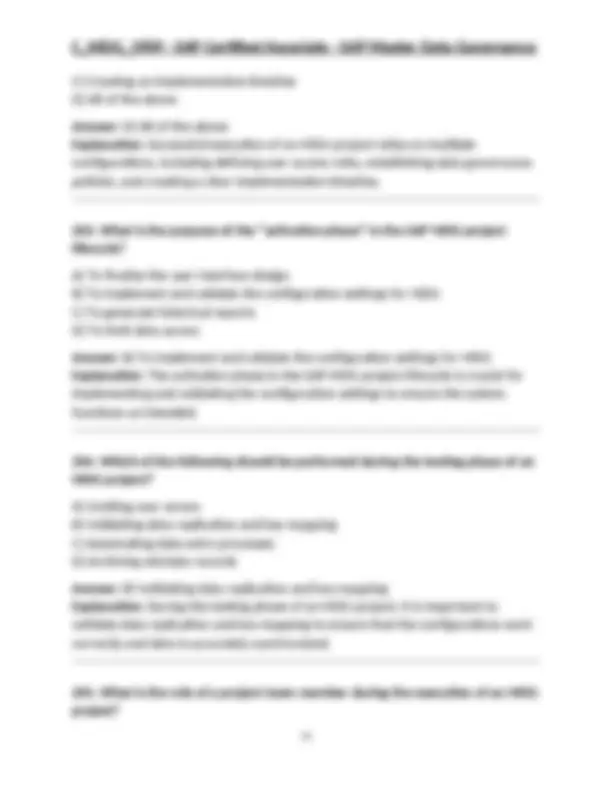
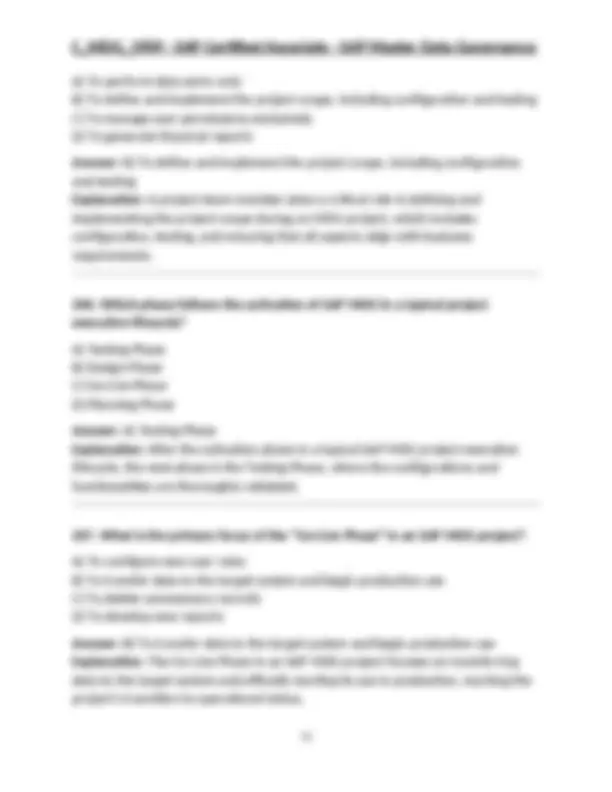
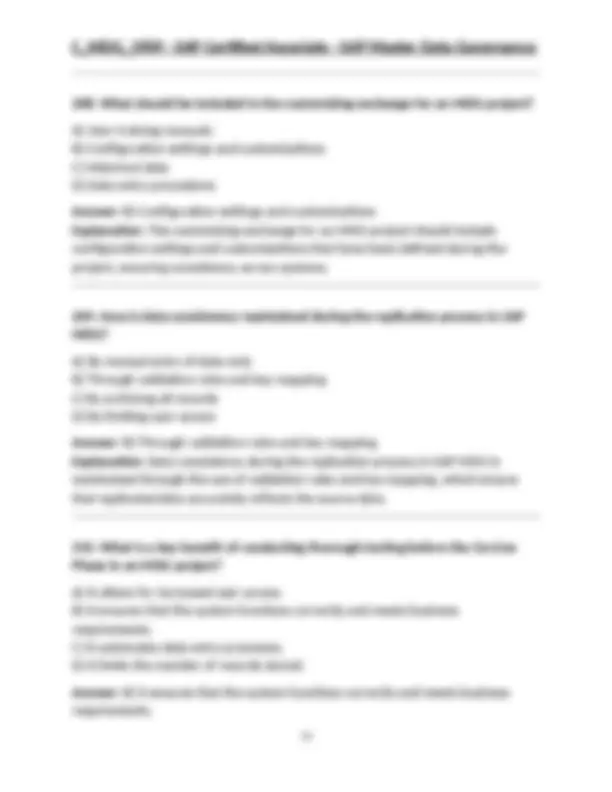
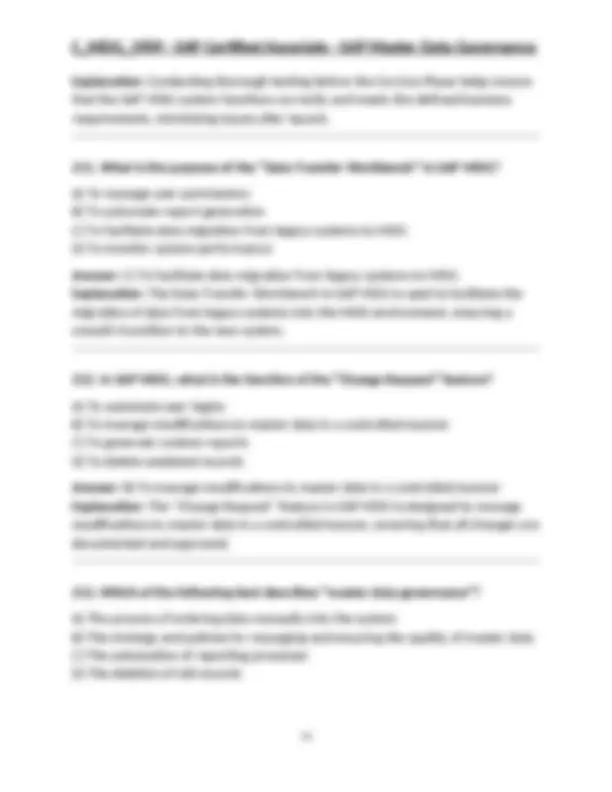
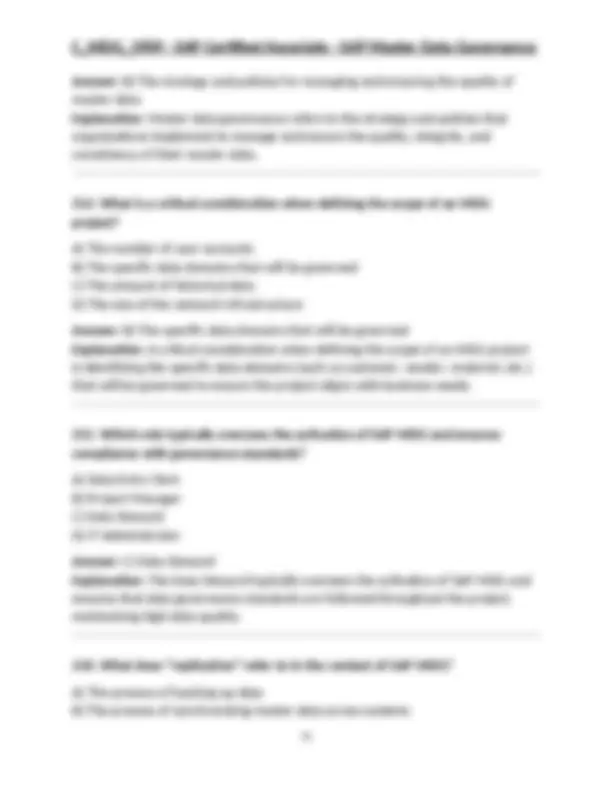
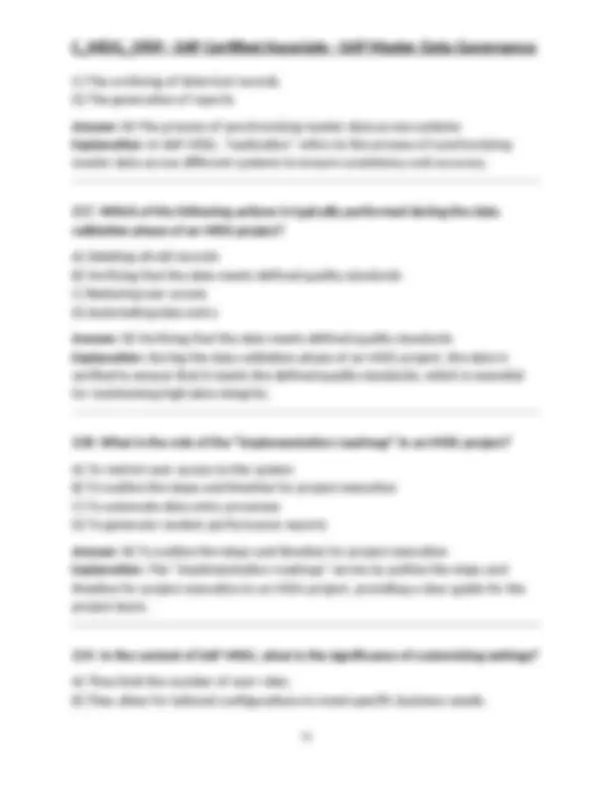
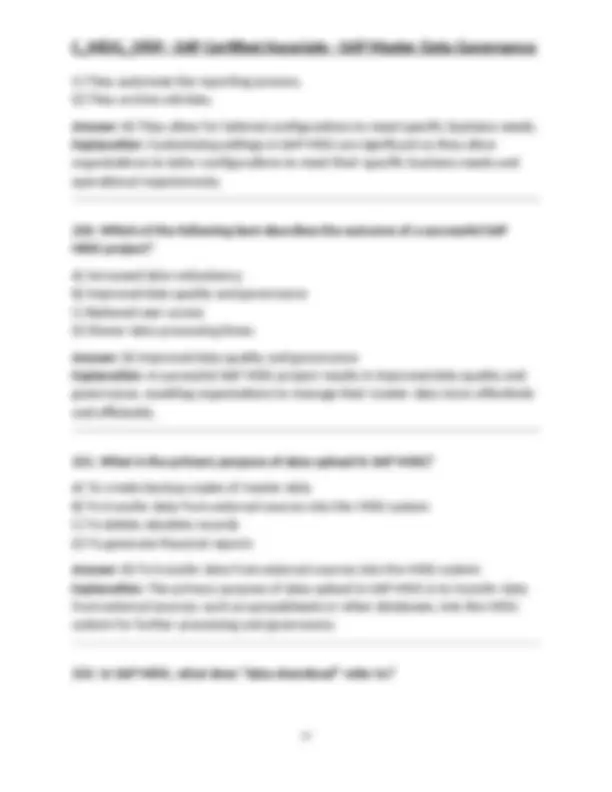
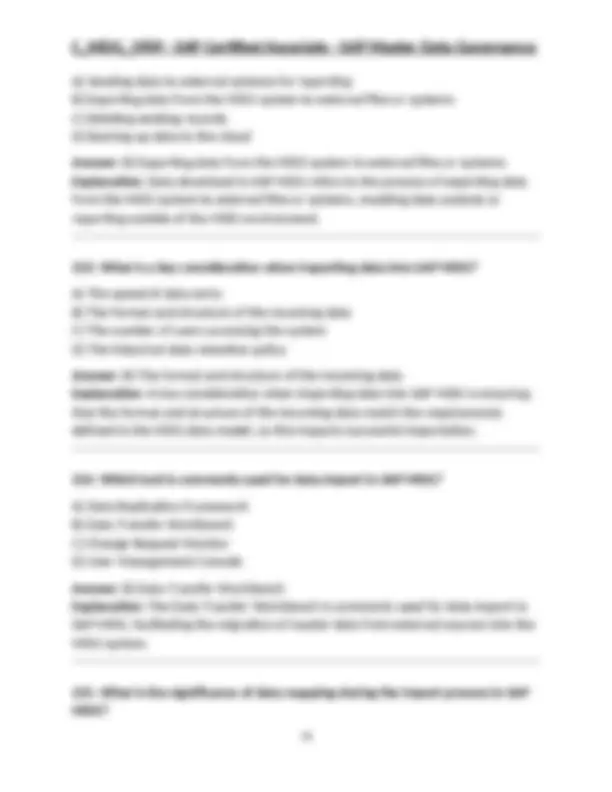
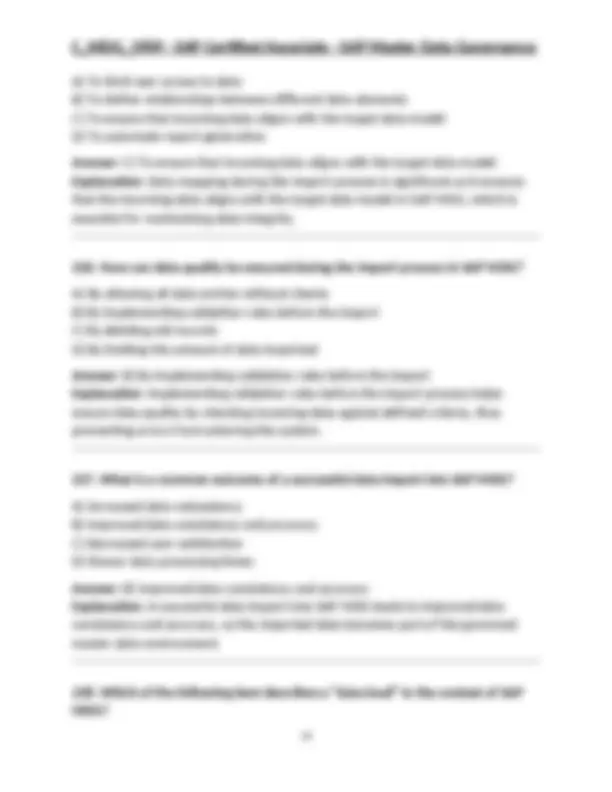
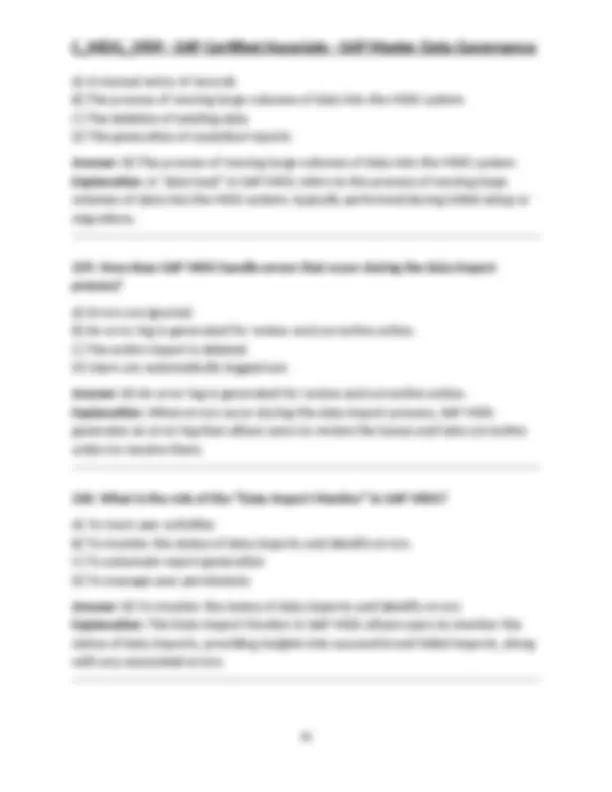
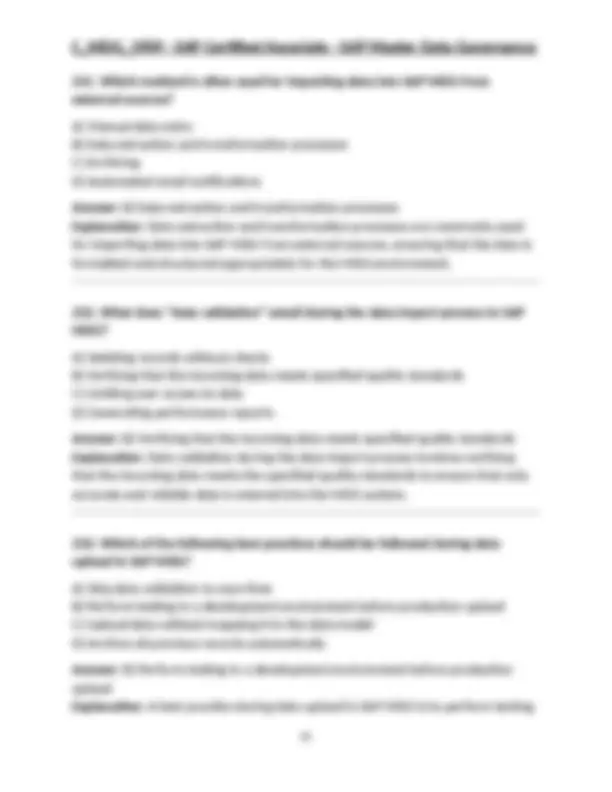
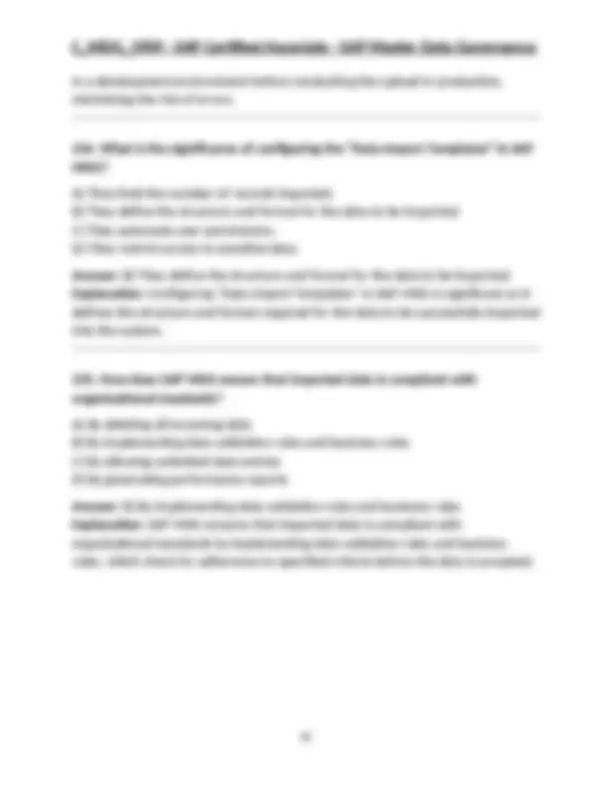


Study with the several resources on Docsity

Earn points by helping other students or get them with a premium plan


Prepare for your exams
Study with the several resources on Docsity

Earn points to download
Earn points by helping other students or get them with a premium plan
Community
Ask the community for help and clear up your study doubts
Discover the best universities in your country according to Docsity users
Free resources
Download our free guides on studying techniques, anxiety management strategies, and thesis advice from Docsity tutors
Various aspects of sap master data governance (sap mdg), a comprehensive solution for managing and governing master data across an organization. It covers topics such as data modeling, data quality management, data validation, data replication, mass processing, data consolidation, and data stewardship. The document highlights the key features and benefits of sap mdg, including centralized governance, data consistency, improved data quality, and streamlined data management processes. It also explores the role of analytics and data profiling in enhancing data quality and the importance of configuring data validation rules to ensure data integrity. Insights into the data import process, data mapping, and the significance of aligning incoming data with the target data model in sap mdg. Overall, the document offers a detailed understanding of the capabilities and functionalities of sap mdg, making it a valuable resource for professionals involved in master data management and governance.
Typology: Quizzes
1 / 82

This page cannot be seen from the preview
Don't miss anything!











































































1. What is the primary purpose of SAP Master Data Governance (MDG)? A) To enhance sales performance B) To manage master data centrally C) To improve customer service D) To analyze business intelligence Answer: B) To manage master data centrally Explanation: SAP Master Data Governance (MDG) is designed to manage master data centrally, ensuring data consistency, accuracy, and compliance across the organization. 2. Which of the following components is a key part of the SAP MDG architecture? A) SAP Fiori B) SAP HANA Cloud C) Data Quality Management (DQM) D) SAP Business Warehouse (BW) Answer: C) Data Quality Management (DQM) Explanation: Data Quality Management (DQM) is essential in SAP MDG architecture as it ensures the integrity and quality of master data. 3. In SAP MDG, what is the role of the Change Request Management (CRM) component? A) To handle data storage B) To track user performance C) To manage and monitor changes to master data D) To generate reports on master data Answer: C) To manage and monitor changes to master data Explanation: Change Request Management (CRM) allows organizations to manage and monitor the lifecycle of changes to master data, ensuring proper governance and compliance.
4. Which of the following data modeling techniques is commonly used in SAP MDG? A) Entity-Relationship Diagram (ERD) B) Star Schema C) Data Vault D) Flat File Structure Answer: A) Entity-Relationship Diagram (ERD) Explanation: Entity-Relationship Diagrams (ERD) are used in data modeling within SAP MDG to visualize the relationships between different data entities. 5. What are the key benefits of using SAP MDG for master data management? A) Improved hardware efficiency B) Centralized governance and data consistency C) Increased sales revenue D) Reduced training costs Answer: B) Centralized governance and data consistency Explanation: SAP MDG provides centralized governance for master data, ensuring data consistency across various systems, which enhances overall data quality. 6. In the context of SAP MDG, what is the significance of data modeling? A) It defines how data is displayed in reports. B) It establishes relationships and structures for master data. C) It determines user access rights. D) It tracks system performance metrics. Answer: B) It establishes relationships and structures for master data. Explanation: Data modeling in SAP MDG is crucial for defining the structure and relationships of master data entities, facilitating effective data management. 7. Which SAP technology is commonly used to store master data in MDG?
C) To store user login credentials D) To manage system performance Answer: B) To define the structure and attributes of master data Explanation: The MDG Data Model defines the structure and attributes of master data entities, which is essential for effective data governance.
11. Which feature allows users to create, change, or delete master data in SAP MDG? A) Data Replication B) Change Request C) Data Import D) Data Archiving Answer: B) Change Request Explanation: The Change Request feature in SAP MDG allows users to create, change, or delete master data, facilitating the governance process. 12. In SAP MDG, what role does "Data Replication" play? A) It reduces data redundancy. B) It allows for real-time synchronization of master data across systems. C) It improves user interface design. D) It provides backup for master data. Answer: B) It allows for real-time synchronization of master data across systems. Explanation: Data Replication in SAP MDG ensures that master data is synchronized across different systems in real-time, maintaining consistency and accuracy. 13. Which of the following is a feature of the SAP MDG architecture? A) Single data entry B) Multi-domain governance
C) Limited data access D) Manual approval processes Answer: B) Multi-domain governance Explanation: SAP MDG architecture supports multi-domain governance, allowing the management of various types of master data, such as material, customer, and supplier data.
14. What is the role of "Data Governance" in SAP MDG? A) To improve network performance B) To ensure compliance and quality of master data C) To manage hardware resources D) To provide technical support Answer: B) To ensure compliance and quality of master data Explanation: Data Governance in SAP MDG ensures that master data complies with regulatory standards and maintains high quality, supporting effective decision-making. 15. What are "Change Requests" used for in SAP MDG? A) To back up master data B) To approve data access rights C) To manage the lifecycle of master data changes D) To improve system performance Answer: C) To manage the lifecycle of master data changes Explanation: Change Requests in SAP MDG are used to manage the lifecycle of master data changes, including creating, modifying, and deleting master data records. 16. Which component of SAP MDG helps ensure data quality by defining validation rules?
A) It limits user access to sensitive data. B) It reduces redundancy and ensures consistency across systems. C) It requires fewer resources to maintain. D) It simplifies network architecture. Answer: B) It reduces redundancy and ensures consistency across systems. Explanation: A centralized approach in SAP MDG helps eliminate data redundancy and maintain consistent master data across various applications and systems.
20. Which SAP Fiori application is commonly used for creating change requests in MDG? A) Manage Material Master Data B) Manage Supplier Data C) Create Change Request D) Monitor Data Quality Answer: C) Create Change Request Explanation: The "Create Change Request" application in SAP Fiori is specifically designed for users to initiate and manage change requests for master data. 21. In SAP MDG, which feature allows organizations to control who can access and modify master data? A) Data Replication B) Authorization Management C) Data Import D) Data Quality Management Answer: B) Authorization Management Explanation: Authorization Management in SAP MDG controls user access to master data, ensuring that only authorized personnel can modify or access sensitive information. 22. Which of the following data models is primarily used for managing business partner data in SAP MDG?
A) Material Data Model B) Business Partner Data Model C) Supplier Data Model D) Customer Data Model Answer: B) Business Partner Data Model Explanation: The Business Partner Data Model in SAP MDG is specifically designed to manage all aspects of business partner data, integrating supplier and customer information.
23. What does the term "Data Governance" imply in the context of SAP MDG? A) The management of system performance B) The creation of user interfaces C) The policies and processes ensuring the accuracy and consistency of master data D) The development of new software features Answer: C) The policies and processes ensuring the accuracy and consistency of master data Explanation: Data Governance in SAP MDG refers to the policies and procedures that ensure master data is accurate, consistent, and compliant with regulations. 24. Which functionality allows for the automatic synchronization of master data between SAP MDG and other systems? A) Change Request Management B) Data Replication C) Data Import D) Data Archiving Answer: B) Data Replication Explanation: Data Replication in SAP MDG automates the synchronization of master data across various systems, ensuring real-time data consistency. 25. What is a key feature of the SAP MDG UI (User Interface)?
A) Manual reviews only B) Automated rules and validation checks C) Data export to external tools D) User feedback surveys Answer: B) Automated rules and validation checks Explanation: SAP MDG uses automated rules and validation checks to ensure that changes to master data comply with defined standards and criteria.
29. What is the primary purpose of the "Data Modeler" tool in SAP MDG? A) To visualize user roles B) To create and manage data models for master data C) To analyze system performance D) To develop user training materials Answer: B) To create and manage data models for master data Explanation: The Data Modeler tool in SAP MDG is used to create and manage data models that define the structure and attributes of master data. 30. How does SAP MDG support regulatory compliance? A) By offering detailed reporting features B) By ensuring accurate and consistent master data through governance processes C) By limiting user access to master data D) By providing training for users Answer: B) By ensuring accurate and consistent master data through governance processes Explanation: SAP MDG supports regulatory compliance by implementing governance processes that ensure master data is accurate, consistent, and compliant with relevant regulations. 31. What is the primary objective of the consolidation process in SAP MDG?
A) To improve data entry speed B) To merge duplicate master data records C) To archive old data D) To enhance user training programs Answer: B) To merge duplicate master data records Explanation: The primary objective of the consolidation process in SAP MDG is to identify and merge duplicate master data records to ensure a single source of truth for master data.
32. In SAP MDG, what is a "match group"? A) A group of users with the same access rights B) A set of records evaluated for similarity C) A collection of approval tasks D) A reporting group for analytics Answer: B) A set of records evaluated for similarity Explanation: A match group in SAP MDG is a set of records that are evaluated for similarity to identify duplicates during the consolidation process. 33. How does SAP MDG calculate the "best record" during consolidation? A) By using random selection B) By evaluating based on predefined scoring rules C) By calculating the average of all records D) By considering only the most recent entries Answer: B) By evaluating based on predefined scoring rules Explanation: SAP MDG calculates the "best record" by evaluating all similar records against predefined scoring rules to determine which record should be retained. 34. Which of the following describes the role of scoring in the consolidation process?
A) To provide real-time system performance metrics B) To analyze and visualize master data quality and consolidation results C) To manage user access rights D) To automate data entry processes Answer: B) To analyze and visualize master data quality and consolidation results Explanation: Analytics in SAP MDG consolidation helps organizations analyze and visualize the quality of master data and the outcomes of consolidation efforts.
38. Which of the following is a benefit of using match groups in SAP MDG? A) Reducing system response time B) Improving the accuracy of duplicate detection C) Simplifying user interface design D) Decreasing data storage requirements Answer: B) Improving the accuracy of duplicate detection Explanation: Match groups enhance the accuracy of duplicate detection in SAP MDG by allowing the system to evaluate records systematically for potential matches. 39. How are scoring rules typically defined in SAP MDG? A) Manually by the users B) Automatically by the system C) Based on external benchmarks only D) Using a standard template without customization Answer: A) Manually by the users Explanation: Scoring rules in SAP MDG are usually defined manually by users to align with the specific requirements and criteria of the organization for consolidating master data. 40. What is the outcome of a successful consolidation process in SAP MDG?
A) Creation of new duplicate records B) Identification and retention of a single, most accurate record C) Permanent deletion of all related records D) Increased complexity in data management Answer: B) Identification and retention of a single, most accurate record Explanation: A successful consolidation process results in the identification and retention of a single, most accurate master data record while eliminating duplicates.
41. What does "best record" signify in the context of SAP MDG consolidation? A) The most frequently used record B) The record with the highest data score C) The newest record in the system D) The record selected by user preference Answer: B) The record with the highest data score Explanation: The "best record" in SAP MDG consolidation is the one with the highest data score, indicating it is the most reliable and accurate based on defined scoring criteria. 42. What is one of the key challenges associated with mass processing in SAP MDG? A) Reducing user permissions B) Ensuring data accuracy and consistency during bulk operations C) Generating reports for single records only D) Managing interface design complexity Answer: B) Ensuring data accuracy and consistency during bulk operations Explanation: One of the key challenges of mass processing in SAP MDG is maintaining data accuracy and consistency while executing operations on multiple records simultaneously.
is a best practice that helps ensure accurate and effective results in managing master data.
46. In SAP MDG, what is the purpose of defining "matching rules"? A) To establish user access rights B) To identify records that are considered duplicates C) To track system performance metrics D) To automate report generation Answer: B) To identify records that are considered duplicates Explanation: Matching rules in SAP MDG are used to identify records that may be duplicates by specifying the criteria for comparing records during the consolidation process. 47. Which of the following processes is involved in the evaluation of records during consolidation? A) User Acceptance Testing B) Scoring C) Data Archiving D) Data Import Answer: B) Scoring Explanation: Scoring is the process involved in evaluating records during consolidation, helping to determine the accuracy and relevance of each record based on predefined criteria. 48. What is the benefit of using "best records" in master data governance? A) It allows for data redundancy. B) It ensures that the most reliable and accurate records are retained. C) It complicates data retrieval processes. D) It limits user access to data.
Answer: B) It ensures that the most reliable and accurate records are retained. Explanation: Utilizing "best records" helps ensure that only the most reliable and accurate master data entries are retained, thereby improving data quality.
49. How does SAP MDG ensure the integrity of data during mass processing? A) By allowing only manual entry of data B) By implementing validation rules and checks C) By ignoring existing data relationships D) By restricting user access to the system Answer: B) By implementing validation rules and checks Explanation: SAP MDG ensures data integrity during mass processing by implementing validation rules and checks, which help maintain high data quality. 50. What role does "analytics" play in the SAP MDG consolidation process? A) It serves as a user interface for data entry. B) It evaluates and reports on data quality and consolidation outcomes. C) It defines user roles and permissions. D) It generates automated backups. Answer: B) It evaluates and reports on data quality and consolidation outcomes. Explanation: Analytics in the SAP MDG consolidation process helps evaluate and report on data quality and the effectiveness of consolidation efforts. 51. Which of the following components can be included in the scope of mass processing in SAP MDG? A) Only new records B) All master data types relevant to the business C) Archived data only D) Non-master data records Answer: B) All master data types relevant to the business Explanation: The scope of mass processing in SAP MDG can include all relevant
Answer: B) Mass Processing Explanation: The Mass Processing functionality in SAP MDG enables users to manage bulk changes to master data efficiently, streamlining the process.
55. How does SAP MDG facilitate the identification of duplicate records? A) By allowing only manual data entry B) By providing tools for record comparison based on matching rules C) By ignoring existing data relationships D) By limiting data processing to individual records Answer: B) By providing tools for record comparison based on matching rules Explanation: SAP MDG facilitates the identification of duplicate records by providing tools that compare records based on predefined matching rules. 56. What is a common approach for resolving conflicts in duplicate records within SAP MDG? A) Deleting all duplicate records B) Manually selecting which record to keep C) Using a conflict resolution process based on scoring D) Ignoring the duplicates Answer: C) Using a conflict resolution process based on scoring Explanation: A common approach to resolving conflicts in duplicate records within SAP MDG is to use a conflict resolution process based on the scoring of each record. 57. In the context of SAP MDG, what is a potential risk of poor mass processing practices? A) Increased user satisfaction B) Enhanced data quality C) Data inconsistency and inaccuracies D) Streamlined data management
Answer: C) Data inconsistency and inaccuracies Explanation: Poor mass processing practices can lead to data inconsistency and inaccuracies, undermining the overall quality of master data governance.
58. What type of analysis can be performed on consolidated data within SAP MDG? A) Financial forecasting only B) User access analysis C) Data quality analysis and trend reporting D) System performance analysis Answer: C) Data quality analysis and trend reporting Explanation: Within SAP MDG, analysis of consolidated data can focus on data quality and trend reporting, helping organizations understand and improve their master data. 59. Which aspect of master data is primarily affected by the consolidation process in SAP MDG? A) User permissions B) Historical data C) Duplicate records D) System architecture Answer: C) Duplicate records Explanation: The consolidation process in SAP MDG primarily affects duplicate records, aiming to identify and merge them to maintain a single accurate master data record. 60. Why is it important to regularly review and update matching rules in SAP MDG? A) To reduce system costs B) To ensure they remain effective in identifying duplicates as business needs change